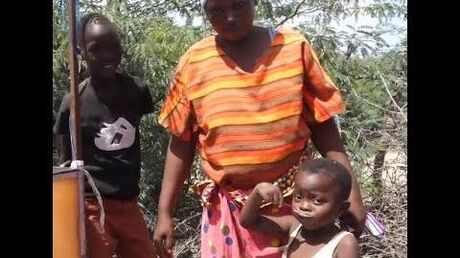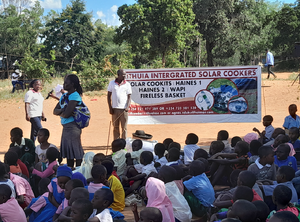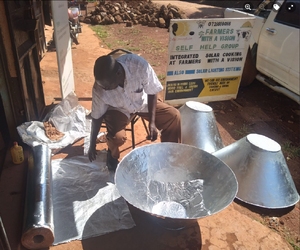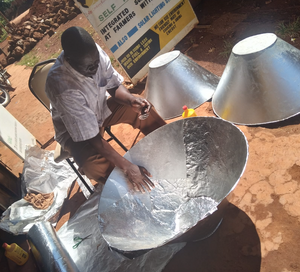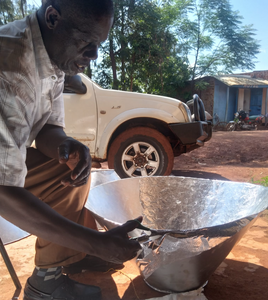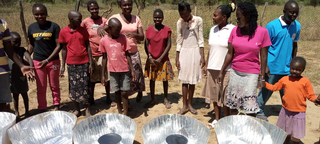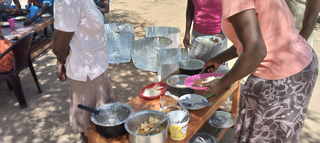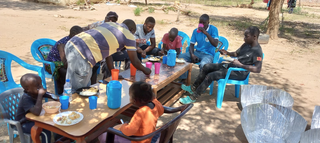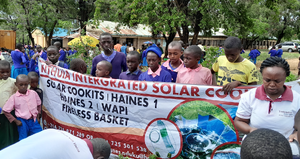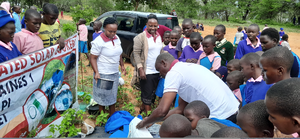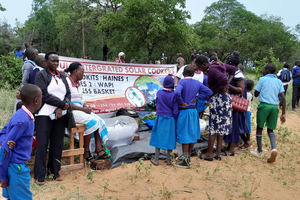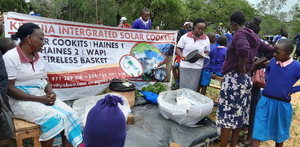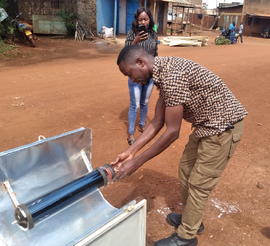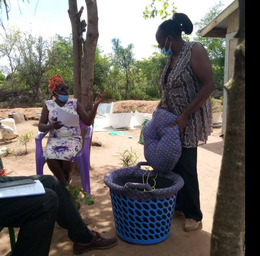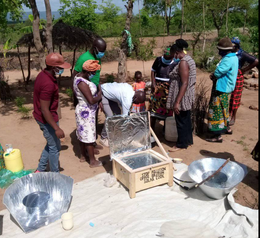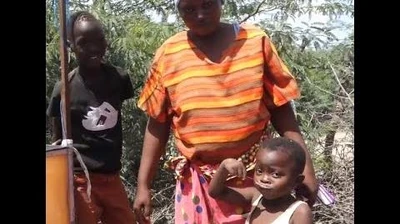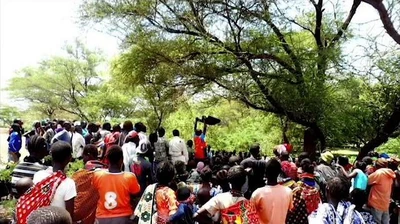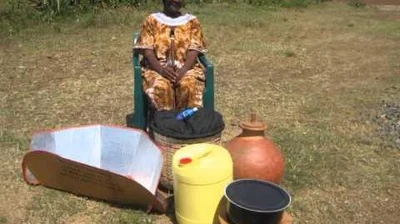Tom Sponheim (talk | contribs) Tag: sourceedit |
Tom Sponheim (talk | contribs) mNo edit summary |
||
| (356 intermediate revisions by 9 users not shown) | |||
| Line 1: | Line 1: | ||
{{GoogleTranslateLinks}} |
{{GoogleTranslateLinks}} |
||
| − | {{Updated| |
+ | {{Updated|4|11|24}} |
| + | {{CountryPageHeader|Solar Cooking in Kenya|In 2019, [[Solar Cookers International]] provided 300 people with solar cookers and the training to use them in the [[Kakuma Refugee Camp]].}} |
||
| − | <table cellspacing="2"><tr> |
||
| − | <td valign="top" width="45%">__TOC__</td> |
||
| − | <td valign="top" width="55%" style="padding:10px;"> |
||
| − | [[Image:Kakuma12.jpg|thumb|370px|Refugees from [[Sudan]] are trained by [[Solar Cookers International]] in the use of their new [[CooKit]] solar cookers.]] |
||
| − | </td></tr></table> |
||
==Events== |
==Events== |
||
{{KenyaEvents}} |
{{KenyaEvents}} |
||
| − | |||
{{CalendarAndPastEvents}} |
{{CalendarAndPastEvents}} |
||
| + | ==Significant project== |
||
| − | |||
| − | ==Most significant solar cooking projects== |
||
[[Image:Kakuma12.jpg|thumb|300px|Refugees from [[Sudan]] are trained by [[Solar Cookers International]] in the use of their new [[CooKit]] solar cookers.]] |
[[Image:Kakuma12.jpg|thumb|300px|Refugees from [[Sudan]] are trained by [[Solar Cookers International]] in the use of their new [[CooKit]] solar cookers.]] |
||
| − | *'''The Kakuma Refugee Camp was the first to receive a large scale solar cooking project''' - The [[Kakuma Refugee Camp]] was formed in 1972 when Sudanese refugees first arrived in Kakuma, |
+ | *'''The Kakuma Refugee Camp was the first to receive a large scale solar cooking project''' - The [[Kakuma Refugee Camp]] was formed in 1972 when Sudanese refugees first arrived in Kakuma, Kenya. Introducing solar cooking to the camp was [[Solar Cookers International]]’s first and largest refugee project, beginning in January 1995. Kakuma had considerable refugee turnover, but by 2004, when Solar Cookers International (SCI) concluded the project, the camp had tripled in size to nearly 90,000 refugees. Though rapid growth posed problems for assisting all those who wanted to solar cook, SCI ultimately served over 15,000 families. This project was one of the earliest to use the [[CooKit]] [[solar panel cooker]] to introduce solar cooking. The program also extended solar cooker technology to schools, especially primary schools, through demonstrations, poems, songs and drama. |
| − | |||
{{SignificantProjectLink}} |
{{SignificantProjectLink}} |
||
| + | =={{HeadingNews}}== |
||
| − | ==News and recent developments== |
||
| + | *{{NewMar24}}'''March 2024: '''Nicholas Kithembe of the [[Tonembee Association]] reports a successful solar cooking demonstration by '''Kithuia Integrated Solar Cookers''' at the primary school games, attended by over 1,000 people at Kithuia Village in [[Kenya]]. |
||
| − | [[File:Imani_Women_Group_November_2015.jpg|right|250px]] |
||
| + | ::::::<gallery widths="300" spacing="small"hideaddbutton="true"columns=2> |
||
| − | *{{NewNov15}}'''November 2015:''' The members of the [[Imani Women Group]] bake cupcakes and larger cakes using only a wooden box and the sun. They earn enough money to help support their families and send their children to school. On a sunny day they produce up to 150 cupcakes, which they sell for 10 shillings (0.10 US$), and 30 cakes that go for 200 shillings (2.00 $US). Kenya, which straddles the equator, receives (according to the Kenyan Ministry of Energy) an average of 4.5 kwh per square meter per day. [http://www.trust.org/item/20151119080630-s7dr0/ Read more...] '''See also: ''' [[Solar restaurants and bakeries]] |
||
| + | Kithuia Solar Cookers demo 1, 3-22-24.png |
||
| + | Kithuia Solar Cookers demo 3, 3-22-24.png |
||
| + | Kithuia Solar Cookers demo 4, 3-22-24.png |
||
| + | Kithuia Solar Cookers demo 5, 3-22-24.png |
||
| + | </gallery> |
||
| + | {{TextAlign|''Photo credit: Nicholas Kithembe''|center}} |
||
| + | *{{NewMar24}}'''March 2024: Producing more Funnel solar cookers:''' - Didacus Pius Odhiambo has provided photos of assembling several more Funnel solar cookers for [[Farmers with a Vision]]. |
||
| − | *'''June 2015:''' On June 10, [[Faustine Odaba]] gave a presentation on solar and fireless cooking to a women's initiative in Ringsaker, [[Norway]] after being invited by several NGOs. |
||
| + | :<gallery widths="300" spacing="small"hideaddbutton="true"columns=3> |
||
| + | FWaV 1, 3-8-24.png |
||
| + | FWaV 2, 3-8-24.png |
||
| + | FWaV 3, 3-8-24.png |
||
| + | </gallery> |
||
| + | {{TextAlign|''Photo credit: [[Farmers with a Vision]]''|right}} |
||
| + | *{{NewOct23}}'''October 2023:''' A celebration at the completion of a successful [[integrated solar cooking]] workshop in Kenya’s Kwale district, led by the engineer Penina Nzioka, with coordination assistance from [[Bernhard Müller]]. |
||
| + | [[File:Bernhard Müller attends workshop celebration, 10-26-23.png|thumb|400px|center|[[Bernhard Müller]] attends the workshop celebration at the completion of participant training, led by engineer Penina Nzioka. The handsome [[Heat-retention cooking|heat-retention baskets]] on display were assembled by the group, ''Photo credit: Penina Nzioka'']] |
||
| + | *{{NewSep23}}'''September 2023:''' [[Camily Wedende]] of [[Sun Cookers International]] provided a solar cooking demonstration to [[Kenya|Kenyan]] locals in West Pokot County. Attendance was greater than expected, so food portions had to be rationed some. Camily used a collection of [[Haines 1]] solar panel cookers provided by [[Roger Haines]] to prepare a midday meal. Participants witnessed solar cooking in action for the first time, and were quite impressed. |
||
| + | ::<gallery widths="320" spacing="small"hideaddbutton="true"columns=3> |
||
| + | Camily 1, 9-13-23.png|Participants pose with the [[Haines 1]] solar cookers |
||
| + | Camily 3, 9-13-23.png|Preparing the ingredients for the solar cookers |
||
| + | Camily 2, 9-13-23.png|Dinner is shared |
||
| + | </gallery>{{TextAlign|''Photo credit: [[Camily Wedende]]''|right}} |
||
| + | *{{NewApr23}}'''April 2023:''' Nicholas Kithembe of the Tonembee Association has provided photos of a recent [[Integrated Cooking Method]] demonstration at Kithuia Village sponsored by Sub Country Sports. They displayed the use of the [[CooKit]], [[Haines 1]] , [[Haines 2.0]] solar cookers, the water purification [[WAPI]] indicator, and how to use a fireless basket for [[Heat-retention cooking|heat-retention cooking]]. |
||
| − | *'''March 2015: Water Boiling Test Results''' [[Bernhard Müller]]'s Water Boiling Test was conducted in February 2015 in Nairobi, [[Kenya]] comparing several types of [[solar panel cooker]]s. One liter of water was used in each cooker. All the cookers showed they were capable of pasteurizing water and cooking food. [[Media:Water_Boiling_Test_(Muller),_3-5-15.pdf|Water Boiling Test results - ''Bernhard Müller'']] |
||
| + | :::::::<gallery widths="300" spacing="small"hideaddbutton="true"columns=2> |
||
| + | Tonembee 1, 4-6-23.png |
||
| + | Tonembee 2, 4-6-23.png|Unpacking the tools for integrated cooking |
||
| + | Tonembee 3, 4-6-23.png|Explaining the basics of the solar cooker |
||
| + | Tonembee 4, 4-6-23.png|The cook pot uses a polycarbonate clear sleeve to help retain the heat |
||
| + | </gallery>{{TextAlign|''Photo credit: [[Tonembee Association]]''|right}} |
||
| + | [[File:Kakuma cooker photo, 3-29-23.png|thumb|300px|Woman examines an [[Ecomandate|Ecomandate Foundation]] built [[:Category:Solar box cooker designs|solar box oven]] at the [[Kakuma Refugee Camp]], ''Photo credit SCI'']] |
||
| + | *{{NewApr23}}'''March 2023: Solar Cookers International in partnership with the Ecomandate Foundation''' - The organizations have implemented an ongoing solar cooking project at the [[Kakuma Refugee Camp]] in [[Kenya]]. [[Solar Cookers International]] emphasizes and applies best practices in project development and project monitoring and evaluation. [[Ecomandate|Ecomandate Foundation]] brings hands-on construction, their local experience as part of the community, and familiarity with local customs, practices, and languages. [https://www.climate-chance.org/en/best-pratices/improving-lives-through-solar-cooking-in-kakuma-refugee-camp/ Read more...] |
||
| + | {{Clr}} |
||
| + | *{{NewFeb23}}'''February 2023:''' A multi-day solar cooker construction and use workshop took place in Eldoret Kenya. It became a reality through the efforts of a number of supporting individuals, non-profit organizations, and manufacturers. The [[solar panel cooker]] materials were provided by [[Haines Solar Cookers]], with general funding by the [https://www.sandiegorotary.club Rotary Club of San Diego]. [[Solar Education Project]] founders, [[Mary Buchenic]] and Jennifer Gasser wrote workbooks and translated them into Swahili for the participants. Additional project support was provided by [[Solar Household Energy]]. The workshop leader was Grace Chepkemei, who was assisted by local solar cooking advocate [[Camily Wedende]]. Participants were excited about the training, and surprised at the variety and excellent taste of the foods they prepared. |
||
| + | ::[[File:Haines Solar Cooking Workshop in Eldoret, Kenya 2022-2|400px|thumb|none]] |
||
| + | *{{NewJan23}}'''December 2022:''' Visit to [[Farmers with a Vision]] by Joshua Katagwa of Mayunge, [[Uganda]] and Maimuna Nangobi of Jinja Renewable Consult, Uganda. They were shown how the [[solar box cooker]] and the [[evacuated tube]] solar cooker are operated, and assembled. |
||
| − | [[File:Friend_of_the_Old_bind_CooKit_edge.JPG|thumb|175px|[[Friends of the Old]] (FOTO) staff members bind the edges of new [[CooKit]]s to make them more durable in Katito, Lower Nyakach, [[Kenya]]. - ''C. Cross'']] |
||
| + | ::<gallery widths="270" spacing="small"hideaddbutton="true"> |
||
| − | *'''March 2015: New CooKits being made more durable in Kenya''' - [[Friends of the Old]] (FOTO) staff members bind the edges of new [[CooKit]]s to make them more durable in Katito, Lower Nyakach, [[Kenya]] |
||
| + | Farmers with a Vision is visited, 12-30-22 copy.png|Using the [[solar box oven]] is explained |
||
| + | Farmers with a Vision is visited, 12-30-22 (2).png|Visiting the FWAV facility |
||
| + | Farmers with a Vision is visited, 12-30-22 (3).png|The operation of the [[evacuated tube]] solar cooker is demonstrated |
||
| + | </gallery> |
||
| + | :::::::::::::::*''Photo credits: Farmers with a Vision'' |
||
| + | *{{NewDec22}}'''December 2022:''' In April 2022 [[Bernhard Müller]] made a video how to make a fireless cookers at Armstrong Women Empowerment Centre in Kisumu, Kenya under the leadership of Elva Rebecca "Beckie" Ondiek. "It took two full days of intense work to make. The video was first published with German subtitles on YouTube. It took me a very long time to look for somebody to help me editing the video in English language. Eventually, [[Sara Hjalmarsson]] of [[Engineers Without Borders - Sweden]] (EWB-S) did this absolutely stunning work." The video is now available by clicking on the link: [https://youtu.be/uglZKm7o0So DIY Heat Retention Baskets - Fireless Cookers] |
||
| + | [[File:Kihuha Bruno demonstrates Haines panel cooker, 12-1-22.png|thumb|300px|Kihuha Bruno demonstrates a [[Haines Solar Cookers|Haines panel cooker]] by preparing a meal at the [[Kakuma Refugee Camp]], ''Photo credit: Kihuha Bruno'']] |
||
| − | *'''November 2014:''' [[Bernhard Müller]] started a fundraiser at [https://www.betterplace.org/de betterplace.org] to support seminars and workshops directed at the use and production of [[fireless cooker]]s for the Kenyan NGOs [[NAREWAMA]] and [[FOTO]]. |
||
| + | *{{NewDec22}}'''December 2022:''' Kihuha Bruno has been a longtime advocate of using solar cooking, particularly with those having limited resources. He has worked frequently at the [[Kakuma Refugee Camp]] in [[Kenya]] demonstrating the effectiveness of [[Haines Solar Cookers]], thereby avoiding [[deforestation]] from firewwood collection, and [[Household air pollution|respiratory illness]] from using open fires for cooking. |
||
| + | [[File:Fireless cookers, Nairobi, Kenya, 8-29-22.png|thumb|300px|Fireless cooker workshop with Samuel Odhiambo in Nairobi, ''Photo credit: [[AfriShiners'']]]] |
||
| + | *{{NewSep22}}'''August 2022: fireless cookers:''' Samuel Odhiambo from [[AfriShiners]] ran a fireless cooker workshop in Nairobi recently. |
||
| + | [[File:Kakuma workshop 2, 5-30-22.png|thumb|300px|The [[Solar Education Project]] reports that Grace Chepkemei shared her skill and knowledge about solar cooking and [[Heat-retention cooking|heat-retention]] basket cooking, ''Photo credit: [[Solar Education Project]]'']] |
||
| + | [[File:Kakuma workshop, 5-30-22 baskets.jpg|thumb|300px|[[Heat-retention cooking]] baskets were constructed at the workshop.''Photo credit: [[Solar Education Project]]'']] |
||
| + | *{{NewJun22}}'''May 2022: Solar and heat retention cooking workshop''' - The [[Solar Education Project]] reports that Grace Chepkemei shared her skill and knowledge about solar cooking and [[Heat-retention cooking|heat-retention]] basket cooking at a workshop at the [[Kakuma Refugee Camp]]. These skills demonstrate how the [[Integrated Cooking Method]] will benefit the trainees and community. |
||
| + | [[File:Solar tunnel dryer, Kenya, Müller, 1-4-22.png|thumb|300px|Solar tunnel dryer designed by [[Bernhard Müller]] for his partners in [[Kenya]] and [[Uganda]] ''Photo credit: [[Bernhard Müller]]'']] |
||
| − | *'''November 2014:''' [[Camily Wedende]] reports that a crowd of around 200 people attended the ceremony and celebration for the successful second project team in Student Solar Cooking Science Projects Eldoret, [[Kenya]], innovators of the [[Hexagon Solar Cooker]]. [[Sharon Cousins]], a long time supporter of the project, wrote a speech for the new graduates. It was read by guest of honor [[John Amayo]]. |
||
| + | *{{NewJan22}}'''January 2022: Solar tunnel dryer design for Kenya and Uganda:''' - [[Bernhard Müller]] offered his design skills in helping to create a new [[:Category:Solar food drying#Solar_tunnel_dryers|solar tunnel dryer]] for his partners in [[Kenya]] and [[Uganda]]. A 10W solar panel powers a fan providing air flow and enables the people who work with the dryer to charge their phones simultaneously. |
||
| + | [[File:Penina Nzioka solar cooking demo., Kwale co. Kenya, 9-6-21.jpg|thumb|300px|Solar cooking demonstration in Mwandogo by Penina Nzioka]] |
||
| − | [[File:Eldoret_student_workshop,_10-28-14.png|thumb|300px|[[Camily Wedende]] instructs another group of young students in the assembly of [[solar panel cooker]]s.]] |
||
| + | *{{NewSep21}}'''September 2021: Solar cooking demonstration in Mwandogo''' - Penina Nzioka conducted a workshop to demonstrate the potential of [[solar box cooker]]s in her hometown, located nearby to Mombasa. |
||
| − | *'''October 2014:''' Here is a recent photo of the latest group of children that [[Camily Wedende]] has been working with, each making their own [[solar panel cooker]]. See more photos at: https://www.facebook.com/pages/Student-Solar-Cooking-Science-Projects-Eldoret-Kenya/213211212064334. Thanks to [[Sharon Cousins]] for helping to post Camily's latest activities. |
||
| + | *{{NewJul21}}'''June 2021: Taxes help and hinder solar cooker sales in Kenya''' - Previously, there has been a value-added tax on the purchase of raw materials used for manufacturing solar cookers within the country. Amounting to roughly 16% in additional cost, manufacturers said the savings will be passed on to the consumer. However the government has also removed the tax exemption for clean cooking appliances, as well as other less polluting technologies. This will discourage wider adoption and slow the improvement of [[Household air pollution|air quality]]. Still widely used, [[charcoal]], retains its tax-exempt status. [https://www.the-star.co.ke/news/2021-06-20-e-paper-kenyans-to-pay-less-for-solar-more-to-buy-jikos/ Read more...] |
||
| − | *'''October 4, 2014:''' The [[Natural Resources and Waste Management Alliance]] was invited to the launch of Kenya Interfaith Network on Environmental Action (KINEA); a network of faith groups that are propelled by their faith values to care for environment. The event was held at Tangaza college in Nairobi and was attended by various universities, colleges, NGOs, and religion groups. The guest of honour was Rt. Rev.Bishop Alfred Kipkoech Arap Rotich, the military ordinariate of the Catholic church in Kenya. The event was attended by over a hundred participants. KINEA engages in programs related to climate change and livelihood enhancement which include: ,promotion of tree growing faith owned/ managed institutions and land, faith based education for sustainable development (ESD), and faith based sustainable agriculture and wildlife conservation programs |
||
| + | [[File:Millicent Anyango store, Kenya, 5-27-21.png|thumb|300px|Millicent Anyango's display of stoves and fireless cookers in Migori County, Kenya]] |
||
| − | [[File:NAREWAMA_logo,_9-24-14.jpg|right|100px]] |
||
| + | *{{NewMay21}}'''May 2021:''' [[Bernhard Müller]] reports in the AfriShiners Newsletter that Millicent Anyango maintains a supply of [[Baba Moto Stove|Baba Moto improved combustion stoves]] and [[Heat-retention cooking|fireless cookers]] from her location in Migori County, [[Kenya]]. She also organizes clean-cooking and fireless cooking workshops throughout western Kenya. Penina Nzioka, another AfriShiner member from Mwandogo nearby to Mombasa, trains the women in her village in the use of fireless cookers, and how to process coconut oil in a [[solar box cooker]]. |
||
| − | *'''September 2014: Launch of new website''' - [[NAREWAMA]], located in Nairobi, [[Kenya]] and under the direction of [[Faustine Odaba]], has brought their organization and renewable energy activities online. Visit at: [http://www.mueller-solartechnik.com/narewama Natural Resources and Waste Management Alliance - NAREWAMA ] |
||
| + | [[File:SCI Order of Excellence, Republic of Kenya, 3-21.png|right|450px]] |
||
| + | *{{NewMar21}}'''March 2021:''' The [[Solar Cookers International]] Order of Excellence annual award for 2020 has been given to the [[Kenya|Republic of Kenya]] for including solar cooking in its Voluntary National Review (VNR) to track progress towards achieving the Sustainable Development Goals (SDGs). The award recognizes the most outstanding people and organizations whose sustained efforts have contributed most to empowering people to cook food and pasteurize water with solar energy. |
||
| + | [[File:John Amayo workshop, Kisumu, Kenya, 1-25-21 copy.png|thumb|300px|[[John Amayo]] conducted a workshop on the [[Integrated Cooking Method]] in Kisumu, [[Kenya]]. ''Photo credit: John Amayo'']] |
||
| − | [[File:FOTO_demonstration_on_Remba_Island,_Kenya,_9-24-14.jpg|thumb|350px|[[FOTO]] staff members Seline and Pamela traveled to remote Remba Island in [[Kenya]] to demonstrate [[solar panel cookers]] and [[hay basket|fireless baskets]]. - ''FOTO'']] |
||
| + | *{{NewJan21}}'''January 2021:''' [[John Amayo]] conducted a workshop on the [[Integrated Cooking Method]] in Kisumu, [[Kenya]]. Participants learned about using solar cookers, [[:Category:Heat-retention cooking|heat retention cooking baskets]], and [[:Category:Improved combustion stoves|improved-combustion stoves]] to best effect in both sunny and cloudy conditions. |
||
| − | *'''September 2014: Remba, the island without wood, welcomes solar cooking''' - Friends of the Old ([[FOTO]]) staff Seline and Pamela went on a four day work trip to Remba Island, [[Kenya]] to promote solar cooking and water testing. Remba Island is on Lake Victoria and is rocky and very remote. There is no firewood or charcoal on Remba Island and must be imported from Mbita by boat. The scarcity of firewood on the island combined with plenty of sunshine makes solar cooking and water pasteurization an ideal solution for the locals. Interest was high at the demonstration and local residents bought the available supply of [[CooKit]]s and [[hay basket|fireless baskets]]. [http://friendsoftheold.blogspot.com/2014/09/foto-goes-to-remba-island.html See more photos of their trip...] |
||
| + | *{{NewJun21}}'''December 2020:''' [[Solar Household Energy]] has adopted the [http://www.she-inc.org/?p=3214 100 Families Project] that provides groceries, cooking devices, and other support for 100 families locked down in the Kariobangi slum in Nairobi Kenya. |
||
| − | [[File:Samaritan's_purse_1.jpg|thumb|250px|Samaritan's Purse]] |
||
| − | *'''March 2014:''' [[Samaritan's Purse]] has provided 40 solar cookers in [[Kenya]] and training on how to use them, primarily to individuals living with HIV/AIDS. As part of the training, Samaritan's Purse includes reforestation techniques. [http://www.samaritanspurse.org/article/cooking-with-the-sun/?utm_source=SPTwitter&utm_medium=social&utm_campaign=m_Y000-SOCM_SocialMedia Read more...] |
||
| + | *{{NewDec20}}'''December 2020:''' [[Samuel Odiambo]] of the Asulma Centre, in conjunction with Didacus Pius Odhiambo of [[Farmers with a Vision]], trained Grace Mubi and Sarah Ndunyo, of Shambani Millers Self Help Group, and a group of villagers from Kitui, [[Kenya]], about the techniques of [[Integrated Solar Cooking]]. |
||
| − | *'''April 2014: Building material supplier in Kenya imports solar cooker supplies''' - [[Roger Haines]] reports that Global Hardware, Ltd., a prominent Nairobi, [[Kenya]] building supply company, globalhardwarekenya@gmail.com, has agreed to purchase a large quantity of reflective foam insulation and polycarbonate plastic film for resale at low cost to solar cooking entrepreneurs. This is expected to reduce to less than $10 the wholesale cost of materials in Nairobi for the newly-designed [[Haines Foam Insulation Cooker|Haines II foam solar cooker]]. The hope is that the availability of these inexpensive materials will promote the creation of new solar cooking entrepreneurs in East Africa. Haines' San Diego Rotary Club will purchase materials for 500 of the new cookers for distribution by the Rotary Club of Gulu, [[Uganda]]. |
||
| + | ::<gallery widths="260" spacing="small"hideaddbutton="true"> |
||
| + | Villagers learn about solar panel cookers.png|Villagers learn about [[solar panel cookers]] |
||
| + | Heat retention cooking is explained to interested villagers.png|[[Heat retention cooking]] is explained to workshop participants |
||
| + | Several types of solar cookers are demonstrated..png|Several types of solar cookers are demonstrated |
||
| + | </gallery> |
||
| + | ::''Gallery photo credit: [[Farmers with a Vision]]'' |
||
| + | *{{NewNov20}}'''November 2020: SCI shares successes at the ReEnergy Africa E-Summit''' - SCI's Executive Director [[Caitlyn Hughes]] discusses the impact of solar cooking around the world and shared success stories from [[Kakuma Refugee Camp]], [[Kenya]]. [https://www.solarcookers.org/about/blog/sci-speaks-reenergy-africa-e-summit?eType=EmailBlastContent&eId=a88f047d-8d6f-4327-b41b-dfee019be594 Watch video] |
||
| + | *{{NewNov20}}'''November 2020:''' A new local partner agreement has been signed between [[Engineers Without Borders - Sweden]] and the [[Asulma Centre Self Help Group]] to diffuse solar cooking to more areas of Kenya. |
||
| + | *{{NewOct20}}'''October 2020:''' [https://citizentv.co.ke/business/ksh-500m-released-for-14-counties-in-off-grid-solar-project-348100/ Ksh.500M released for 14 counties in off-grid solar project] - ''Citizen Digital'' |
||
| + | *{{NewOct20}}'''October 2020:''' [https://www.businessdailyafrica.com/bd/news/counties/counties-get-sh500m-for-solar-clean-cooking-kits-2484310 Counties get Sh500m for solar, clean cooking kits] - ''Business Daily'' |
||
| + | *{{NewMay20}}'''May 2020:''' '''Kenya inventor wins American Society of Mechanical Engineers (ASME) award for solar cooker boiler''' - "Ecobora invented a “solar cooking boiler”, which stores solar energy in a repurposed oil tank with waste motor oil as carbon sink tank, eliminating need for firewood and allowing use to cook round the clock. Rural marginalized schools in Kenya are using money saved from not buying wood to equip science and computer labs." [https://www.dailytrust.com.ng/nigerian-inventor-wins-asme-innovation-award.html More information] |
||
| + | *{{NewMar20}}'''March 2020: Global Off-Grid Solar Forum & Expo''' - The three-day forum and exposition opened in Nairobi on February 18th with many contributing experts from various parts of the world. The President of [[Kenya]], Uhuru Kenyatta, was also present on the first day of the Expo to assure his government's enthusiastic support for the development of off-grid solar products for use in Kenya. The science of solar cooking and e-cooking were also featured topics of discussion at the forum. [https://www.devdiscourse.com/article/international/881927-global-off-grid-solar-forum-expo-3rd-day-on-e-cooking-growing-solar-biz-paygo-companies-more More information...] |
||
| − | *'''November 2013: Study of water treatment in Kenya demonstrates the effectiveness of the WAPI''' - [[Bob Metcalf]], research microbiologist, and [[FOTO]] worked together on a study to compare results of various water treatment chemicals to the [[WAPI]] water pasteurization indicator used with a [[CooKit]] solar cooker. One finding of note is that the WAPI, when used with the CooKit, was 100% effective in producing negative results for E.coli, while the WaterGuard (3 drops/liter) method was only effective in most cases. Read the study at: [[Media:Eliminating_Water-bourne_Disease_Lower_Nyakach_Kenya_2013.pdf|The Goal is Zero: A Strategy to Eliminate Water-bourne Disease in Lower Nyakach, Kenya]] |
||
| − | [[File: |
+ | [[File:SCI_Kakuma_02-20.jpg|thumb|300px|Kakuma residents with on of the [[Heliac]] solar cookers provided by [[Solar Cookers International]]]] |
| + | *{{NewFeb20}}'''February 2020:''' In 2019, [[Solar Cookers International]] provided 300 people, women and their families, with solar cookers and the training to use them in the [[Kakuma Refugee Camp]]. [https://www.solarcookers.org/application/files/8315/6089/1215/Newsletter-Summer_2019_final.pdf More information...] |
||
| − | *'''October 2013:''' [[Faustine Odaba]] and [[Nicholas Okeya]] present a solar cooking and [[haybasket]] during a festivity of the Catholic Church in Nairobi. |
||
| + | *{{NewFeb20}}'''November 2019: Community bakery''' - [[GoSol.org]] reports that one of their [[:Category:Solar array cooker designs|solar array cookers]], first put into use in 2017 in the Kisumu area, in [[Kenya]] is still in use. It was later transferred to Friends of Ndere, a very active baking community, which already had a GoSol concentrator. In spite of this being one an early pilot unit, they are still using this unit to bake bread. Below is a video in Swahili showing the concentrator in action. [https://gosol.org/best-validation-ever-in-kenya More information...] |
||
| − | [[File:Haines_Cooker_(Side).jpg|thumb|300px|[[Haines Solar Cooker]]]] |
||
| − | *'''May 2013:''' San Diego, {{state|California}}, [[USA]] Rotary Clubs have partnered with Rotary Clubs in [[Kenya]] to provide three hundred [[Haines Solar Cooker]]s, designed by California resident [[Roger Haines]], for a pilot project with a community in Kenya. Director of the Kenya-based Natural Resources and Waste Management Alliance (NAREWAMA) [[Faustine Odaba]] is supervising this project. This new solar cooker design is made from commercially available, reflective bubble insulation. The plastic bag has been replaced by a clear strip of polycarbonate film, which is rolled into a cylinder and secured with clips to support the cook pot. |
||
| + | ::[[File:SOL5 Technology - Solar Energy for SMEs|thumb|none|400 px|Solar Energy for SMEs (English)]] |
||
| − | *'''May 2013: Safe water packages helping in Kenya''' - [[Solar Cookers International]] released information on the their latest efforts to offer safe water packages to low-income families in [[Kenya]]. The package contains all the necessary components to use the [[Integrated Cooking Method|integrated cooking]] approach, which means using the [[solar panel cooker]] to heat water and kill pathogens when it is sunny, and using an efficient [[Rocket Stove|fuel stove]] when it is not. A [[haybasket|heat retention basket]], or "fireless cooker" is included to keep cooked food warm, and to extend cooking times. Working with their partners, who provide the training and follow-up, they have distributed 212 safe water packages from November 2012 through April 2013. These packages have provided over 1,000 people a virtually cost free way to maintain a healthy water supply and prepare their meals. SCI has set a goal to increase the number of packages they fund from 35 per month to 100 per month through the fall of 2013. Please consider [https://www.epa316.net/donate/donate.aspx donating to SCI] to help reach this goal. [[File:Solar Cookers & Safe Water 2013 Goals|none|400 px]] |
||
| + | ::[[File:Friends of Ndere-0|thumb|none|400 px|A video in Swahili showing the concentrator in action]] |
||
| + | [[File:Farmers_with_a_Vision_-_February_2019.jpg|thumb|200px|Farmers with a Vision cooking in front of store]] |
||
| + | *{{NewJan20}}'''April 2019:''' [https://www.reuters.com/article/us-kenya-solar-cooking-idUSKBN17C2KG Kenya learns to cook with solar power - even when the sun doesn't shine] - ''(Reuters)'' In Busia County, in western Kenya, as many as 1,500 households have turned to solar cooking, mostly over the last four years, according to county Ministry of Energy figures. Other families have adopted more efficient charcoal or firewood stoves. The changes in large part have been driven by [[Farmers with a Vision]] (FWA), a local community organization based in Bumala Township. |
||
| + | *{{NewOct19}}'''June 2019:''' [https://www.solarcookers.org/about/blog/alans-journal-kakuma Dr. Alan Bigelow's Journal on Kakuma Refugee Camp, Kenya] - ''[[Solar Cookers International]]'' |
||
| + | [[File:SCI_PEP_University_of_Nairobi_Kenya_2019.jpg|thumb|300px|The [[Performance Evaluation Process]] in action]] |
||
| + | *{{NewJun19}}'''June 2019: Solar Cookers International opens new [[Performance Evaluation Process|PEP]] testing center at the University of Nairobi, [[Kenya]]''' - SCI’s PEP test allows manufacturers and consumers to know the cooking power of solar cookers without brand bias and to develop a baseline for comparison. PEP testing demonstrates to solar cooker users and investors the power, in watts, they can expect from a specific model of solar cooker. SCI PEP results are trustworthy because the PEP test is based on an internationally accepted protocol for testing and reporting solar cooker performance. SCI also has centers in Lalitpur, [[Nepal]]; New York, [[USA]]; and California, USA. Having global locations for SCI PEP testing centers is important to advancing the adoption of solar cooking worldwide and affirms SCI’s role as the leader within the solar cooking sector. Local testing of solar cookers supports the regional economy, job growth and builds capacity in the sector. <ref>[http://www.globalsolarcouncil.org/solar_cookers_international_sci_recently_opened_a_new_solar_cooker_performance_evaluation_process_pep_testing_center_at_the_university_of_nairobi_kenya Global Solar Council newsletter - June 2019]</ref> |
||
| + | [[File:Kakuma_2019.jpg|thumb|300px|Refugee women with a [[Heliac Solar Cooker]]]] |
||
| + | *{{NewJun19}}'''June 2019:''' [[Solar Cookers International]] has recently brought life-saving solar cooking to more than 300 people in the [[Kakuma Refugee Camp]]. Before you stepped in, women were often forced to sell their precious food rations for cooking fuel, putting their children at risk of malnutrition. If they dared to journey outside of the camp to collect [[firewood]], they risked violence. |
||
| + | [[File:Fireless_cooker_workshop_Faustine_O.,_Kenya,_3-5-18.png|thumb|300px|[[Heat-retention cooking|Fireless cooker]] workshop held at the Armstrong Women Empowerment Centre in Rabuor under the direction of [[Faustine Odaba]]. ''Photo credit: [[John Amayo]]'']] |
||
| + | *{{NewMar18}}'''March 2018:''' The [[Heat-retention cooking|fireless cooker]] workshops held at the Armstrong Women Empowerment Centre in Rabuor are made possible with donations from [[Lernen - Helfen - Leben e.V.]] in [[Germany]]. The workshop is led by [[Faustine Odaba]] of [[Natural Resources and Waste Management Alliance]] (NAREWAMA) based in Nairobi. |
||
| + | *{{NewFeb18}}'''February 2018:''' New [[Scheffler Community Kitchen|Scheffler cooker]] installed by [[Altener Solar]]: [https://www.facebook.com/868825929814590/videos/2134479336582570/ Facebook video] |
||
| + | *{{NewJan18}}'''January 2018:''' The [[Tonembee Association]] reports that it distributed 150 solar cookers in Kithuia Village in April, 2017 and held three educational events in the area between February and June, 2017. |
||
| + | [[File:Muller1_11-17.jpeg|thumb|right|300px|''Photo credit: [[Bernhard Müller]]]] |
||
| + | {{OldNewsLink}} |
||
| − | *'''March 2013:''' [[John Amayo]], with [[SURE]], reports that the Ministry of Agriculture in [[Kenya]] recently held a farmers field day, providing an event for local farmers to come and see new ideas. SURE participated, and were able to demonstrate solar cooking using the [[CooKit]], a [[parabolic solar cooker]], and a [[Pulsee Solar Cooker]]. The farmers were pleased with the meat stew prepared in the box cooker, the roasted meat on the parabolic, and water pasteurization with the Pulsee. We also used the heat retention basket on this particularly windy day. It was rewarding to be able to show how the water available was not safe for drinking, and how solar water pasteurization can make it safe. |
||
| + | =={{HeadingClimateCulture}}== |
||
| − | *'''February 2013: Kisumu County receives water pasteurization information''' - Former SCI [[Kenya]] staffer [[John Amayo]] runs [[Sustainable Utilization of Renewable Energy]] (SURE) in the Kadibo division of Kisumu County. With the help of [[Solar Cookers International]] and [[Bob Metcalf]]'s portable microbiology lab, SURE has been able to test local water sources and has distributed thirty safe water packages to the vulnerable in the community. The safe water packages provided by SCI which SURE distributes, like the ones received by FOTO beneficiaries, are accompanied by programs to educate the community on hand washing, food safety, cleanliness around the home, and solar pasteurizing or chemically treating all drinking water. SURE also has plans to harness wind power for lighting and promote the use bio-fuels like biogas for lighting and cooking. |
||
| + | *{{WikipediaClimate|https://en.wikipedia.org/wiki/Climate_of_Kenya}} |
||
| + | *{{NewAug19}}{{EnergySituationEnergypedia}} |
||
| + | *[[Africa#Eastern_Africa|Discussion of eastern Africa's suitability for solar cooking]] |
||
| + | *[[Solar cooker dissemination and cultural variables]] |
||
| + | ==Resources== |
||
| − | *'''November 2012: Student Solar Cooking Science Projects, USA and Kenya''' - What began as a pilot project in Eldoret, [[Kenya]] has evolved into two sister organizations, [[Student Solar Cooking Science Projects]], founded by [[Sharon Cousins]] in the [[USA]] and a sister organization in Kenya founded by [[Camily Wedende]]. Ongoing fundraising goals include renting a small work facility. Because of limited funding, the group is always looking for ways to produce a reasonable solar cooker for $10 USD or less. The partnership that led to these projects began when Camily Wedende of Eldoret read about an American youth project advised by Sharon Cousins, and contacted Sharon asking for advice on working with young people. The pilot project, which involved twenty students ages 10-18, was a stunning success. The innovative approach teaches skills that will help the students in many areas of life. They hope to create a replicable model for the harnessing the tremendous energy and enthusiasm of young people for the advancement of solar cooking in their communities and beyond. |
||
| + | {{ContinentInfo|Africa}} |
||
| + | {{FacebookGroups}} |
||
| + | ==={{HeadingProjectEvals}}=== |
||
| − | [[File:Gaketha_Laura_Energy_Saving_Group_gathering,_11-12.jpg|thumb|300px|Gaketha Laura Energy Saving Group gathering, November, 2012]] |
||
| + | *{{NewJan17}}'''October 2008:''' [[Media:Sunny Solutions Nyakach evaluation - 2008.pdf|Sunny Solutions Project in Nyakach Constituency, Nyanza Province, Kenya - Evaluation Report to Solar Cookers International]] - An independent evaluation of the [[Sunny Solutions|Sunny Solutions Project]] in Nyakach Constituency, Nyanza Province, Kenya. The report examines the impact of solar cooking on the area, associated variables, the results of the project, and recommendations for how to improve future projects. |
||
| − | *'''November 2012: [[Integrated Cooking Method]] promoted in Kenya''' - [[Ingelore Kahrens]] reports that last summer she went to [[Kenya]] again for five weeks to celebrate the birthday of the newly founded [[Mount Kenya Integrated Community Development Organization]] (MKICDO). The [[Gaketha Laura Energy Saving Group]], which was founded after Ingelore's first visit in 2009, is promoting the use of fuel-efficient stoves and basket cookers, as well as promoting soil and crop management practices. A [[Lazola-Initiative|LAZOLA 3]] [[solar box cooker]] was introduced, which was approved by the board members of MKICDO. The group is planning to train artisans at a training center near Chogoria on how to build the cooker. On September 28th, the Lazola 3, along with a basket cooker and a fuel-efficient stove, was taken for demonstration to a divisional show. The County Commissioner from Kitui, the Assistant Minister for Agriculture and many other people were delighted to eat rice that was cooked with the sun.” Read more: [[Media:Ingelore_Kahrens_Kenya_report,_11-12.pdf|Gaketha Laura Energy Saving Group update, November 2012]] |
||
| + | *{{NewJan17}}'''September 2008:''' [[Media:Sunny Solutions Final Report 2008.pdf|Sunny Solutions Program, Nyakach, Kenya - Evaluation Report to Solar Cookers International]] - An independent economic analysis of the [[Sunny Solutions|Sunny Solutions Project]] focusing on how the business model for similar projects could be improved in the future. |
||
| − | [[File:Hexagon_Solar_Cooker,_Eldoret_Student_Projects_11-29-12.jpg|thumb|300px|An Eldoret student displays the [[Hexagon Solar Cooker]] they have designed in their science project class.]] |
||
| − | *'''November 2012:''' Students with [[Eldoret Student Projects]] have designed a new solar cooker called the [[Hexagon Solar Cooker]]. The bottom portion of the cooker has six angles, with a two foot tall reflector at the rear. It a powerful cooker that cooks food in less than three hours with good sunshine. The students used paper cardboard, aluminum foil and glue. Each student earns the materials for their cooker by helping to build and test prototypes and keeping good records of their observations. New students have registered to begin making the new solar cooker design. |
||
| + | *{{NewJan17}}'''March 2007:''' [[Media:Dissemination in Kenya Case Study Dennery 2007.pdf|Solar Cooker Dissemination in Kenya - Evaluation Report to Solar Cookers International]] - A summary of economical, environmental, and health-related issues in rurual Kenya that have the potential to be remedied with the use of solar cookers. Report includes conlcusions of the project and lessons learned. |
||
| − | [[File:Gaudenziah Wedende pours sun cooked tea for a customer., 2-21-12.jpg|thumb|150px|Gaudenziah Wedende pours sun cooked tea for a customer at the Seeing is Believing Cafe.]] |
||
| − | *'''February 2012: '''[[Camily Wedende|Camily and Gaudenziah Wedende]] have started the Seeing is Believing Cafe in Eldoret, [[Kenya]]. They are cooking cakes, tea, and other solar-cooked goodies, and selling them in front of their [[Sun Cookers International]] business. Tanya Cothran, Director of [[Spirit in Action]], [http://godsspiritinaction.org/solar-cookers-cafe/ writes about their cafe] on the Spirit in Action's blog. |
||
| + | *{{NewJan17}}'''April 2006:''' [[Media:Lasting Impacts of Solar Cooker Projects.pdf|Summary of Lasting Impacts of Solar Cooker Projects - Solar Household Energy, Inc.]] - A general summary of long-term effects of solar cooker use in refugee camps in [[Ethiopia]], Kenya, and Bolivia. |
||
| − | *'''February 2012:''' [[Peter Mwathi]] has been developing an inexpensive solar water heating system, designed to provide warm water for domestic tasks. The water is stored below ground, and has stayed warm enough to use for as long as three days. It is not intended to be a water pasteurization system. He says a system costing Sh. 20,000 can heat water for up to 200 people, while another with measurements of 30 m. by 3 m. can heat water for 600 people. [http://mashinani411.site.co.ke/2012/02/16/exploiting-solar-energy-nyeri-man-best-alternative/ Read more...] |
||
| + | *{{NewJan17}}'''December 2003:''' [[Media:Kakuma evaluation 2003-12.pdf|Evaluation of the Solar Cookers International Solar CooKit Project at the Kakuma Refugee Camp, Kenya]] - The final evaluation of the [[Solar Cookers International]] project at the [[Kakuma Refugee Camp]] in Kenya. Report discusses the decreased dependence on wood as fuel, environmental effects, and socio-cultural impacts. |
||
| − | {{OldNewsLink}} |
||
| + | *{{NewJan17}}'''August 1998:''' [[Media:Summary of wood consumption study in Kakuma by Drs. B. Knudson and B. Lankford August 1998. in Kakuma.pdf|Summary of wood consumption study in Kakuma by Drs. B. Knudson and B. Lankford August 1998.]] - A paper discussing the methods and findings of a pilot study conducted in the [[Kakuma Refugee Camp]] to determine the effects of solar cooker use on fuelwood savings. |
||
| − | ==The history of solar cooking in Kenya== |
||
| − | [[Image:Food_versus_charcoal.jpg|right|thumb|300px|Each group of items costs the same as does the pile of charcoal shown. By using a [[CooKit]] or other solar cooker, people can buy food instead of fuel.]] |
||
| − | Kenya is the center of solar cooking activity in East Africa. A number of organizations are endeavoring to promote the technology in this country, which has been the commercial hub of the area for several decades. Its capital, Nairobi, is also well served by air, making access to the nation and region readily available, using Nairobi as entry point. |
||
| + | ===Reports=== |
||
| − | The promotion of solar energy is decades old in Kenya. As far back as 1977, [[GTZ]] |
||
| + | *{{NewApr23}}'''March 2023:''' [[Media:Eldoret National Show Report, 1-4 March 2023.pdf| Eldoret National Show Report, 1-4 March 2023,]] - ''Grace Chepkemei'' |
||
| − | (the Germany's official technical aid agency) initiated and later abandoned a project in Nairobi. The reason given had to do with the fact that products used were made in [[Germany]] and not available in East Africa. Two different Catholic missions in rural Kenya seem to have tried solar cooking, but no information is available on outcomes. As early as 1991, some ovens were exported to [[Tanzania]] (through [[Trans World Radio]], perhaps), indicating that the product presented a business opportunity. In 1992, an Earthwatch grant permitted an academic, Dr. [[Daniel Kammen]], to initiate a multi-year study of renewable energy technologies, including solar cookers, using volunteers in short-term [[Earthwatch]] projects. |
||
| + | *{{NewApr23}}'''March 2023:''' [[Media:Chalmers Masters Thesis on Kenya Solar Cooking.pdf|Chalmers Masters Thesis on Kenya Solar Cooking]] - ''Alaa Abdul Sater & Johanna Tolly'' |
||
| + | *{{NewNov20}}'''April 2020:''' [[Media:Kenia Brief April 2020 Mount Kenya Energy Project.pdf|Kenia Brief (German)]] - ''[[Mount Kenya Energy Project]]'' |
||
| + | *{{NewSep19}}'''July 2019:''' [[Media:The-Kenya-eCookbook-Beans-Cereals-edition-3-July-FULL-RECREATED-WEB-1-4mb.pdf|The Kenya eCookbook: Beans & Cereals Edition - How to Save Time and Money]] |
||
| + | *{{NewMay17}}'''May 2017:''' [[Media:Solar Cooking—the solution to environmental impact and fuel scarcity in Kakuma Refugee Camp - Godfrey Mawira Kaburu 2017.pdf|Solar Cooking—the solution to environmental impact and fuel scarcity in Kakuma Refugee Camp]] - ''Godfrey Mawira Kaburu'' |
||
| + | *{{NewFeb17}}'''January 2017:''' [[Media:The Loodariak Kenya Village Solar Cooker Project - Collaborative Knowledge Transfer Golden.pdf|The Loodariak Kenya Village Solar Cooker Project - Collaborative Knowledge Transfer]] - ''Jean Golden and Peter Haastrup'' |
||
| + | *{{NewMar16}}'''October 2013:''' The Goal is Zero: A Strategy to Eliminate Water-Borne Disease in Lower Nyakach, Kenya ([[Media:A Strategy to Eliminate Water-borne Disease in Lower Nyakach Kenya - Metcalf and Chienjo .pdf|Report]] and [[Media:Friends of the Old, Kenya 2014.pdf|Slides]]) |
||
| + | *'''June 2010:''' [http://www.globalgiving.co.uk/pfil/1202/Solar_Cooking_at_the_Mara.pdf Solar Cooking Demonstration at the Mara in Narok; Kenya] |
||
| + | *'''July 2008:''' [[Media:East Africa Report - Karyn Ellis - July 2008 .pdf|East Africa Report - ''Karyn Ellis'']] |
||
| + | *'''May 2008:''' [[SCI’s Kenya Program: Sunny Solutions and Beyond]] - ''[[Karyn Ellis]]'' |
||
| + | *'''September 2006:''' [http://www.solarcooking.org/research/specialchallenges4solarcooking.pdf The Special Challenges of Solar Cooking] |
||
| + | *'''Fall 2006:''' [http://web.princeton.edu/sites/pumpala/pumpala/teaching%20outreach/ishani/Ishani.htm Mpala, Kenya: A Summer of Teaching, Research, and Learning] - ''[[Ishani Sud]]'' |
||
| + | *'''June 2006:''' [http://solarcooking.org/lasting-impacts.htm Lasting Impacts of Solar Cooking in Kenya] ''- Melanie Szulczewski, Ph. D.'' |
||
| + | *[http://solarcooking.org/kakuma-m.htm A page with chronological reports from the Solar Cookers International solar cooking project in the Kakuma Refugee Camp in Kenya]. |
||
| + | *'''May 2003:''' [http://solarcooking.org/research/KeyanSolarOvenMarket.pdf A Market-Based Strategy for Introducing Passive Solar Ovens in Kenya] |
||
| + | ===Articles in the media=== |
||
| − | Other early efforts included the work of Trans World Radio to promote solar use, |
||
| + | *{{NewSep23}}'''September 2023:''' [https://solacebase.com/kano-acresal-project-coordinator-graced-the-africa/ 2023 Summit: Kano ACReSAL Project Coordinator atins Other Experts at Africa Climate Summit In Nairobi in building solar cooking resilience] - ''Solace Base'' |
||
| − | promotion within the Girl Guide organization, a large project under the auspices of the [[Institute for Cultural Affairs]], and the activities of a remarkable Peace Corp Volunteer. In the mid-1990s, with assistance of [[Solar Cookers International]] (SCI) a national coordinating body for the purpose of sharing information and strengthening progress by collective action around the topic of solar cooking was formed in Nairobi. |
||
| + | *{{NewFeb23}}'''February 2023:''' [https://www.the-star.co.ke/counties/central/2022-10-23-mirror-solar-cooker-invention-to-reduce-deforestation/ Mirror solar cooker invention to reduce deforestation] - ''STAR'' |
||
| + | *{{NewFeb23}}'''February 2023:''' [https://www.africanews.com/2023/02/04/kenyan-solar-stove-may-cut-cancer-risks-caused-by-burning-wood/ Kenyan solar-stove may cut cancer risks caused by burning wood] -''Africa News'' |
||
| + | *{{NewMar21}}'''March 2021:'''[https://www.the-star.co.ke/news/2021-03-01-kenya-recognised-globally-for-promotion-of-clean-cooking/ Kenya recognised globally for promotion of clean cooking] - ''The Star'' |
||
| + | *{{NewMay21}}'''November 2020:''' [https://www.kenyacic.org/2020/11/innovative-solar-cooker-transforming-households/ Innovative Solar Cooker, Transforming Households] - ''Kenya Climate Innovation Center'' |
||
| + | *{{NewOct20}}'''October 2020:''' [https://citizentv.co.ke/business/ksh-500m-released-for-14-counties-in-off-grid-solar-project-348100/ Ksh.500M released for 14 counties in off-grid solar project] - ''Citizen Digital'' |
||
| + | *{{NewOct20}}'''October 2020:''' [https://www.businessdailyafrica.com/bd/news/counties/counties-get-sh500m-for-solar-clean-cooking-kits-2484310 Counties get Sh500m for solar, clean cooking kits] - ''Business Daily'' |
||
| + | *{{NewJun20}}'''June 2020:''' [https://www.standardmedia.co.ke/article/2001374607/experts-oppose-tax-proposal-on-solar-and-cookstoves Experts oppose tax proposal on solar and cookstoves product] - ''Standard'' |
||
| + | *{{NewNov19}}'''November 2019:''' [https://www.energia.org/kenyan-ministry-of-energy-launches-first-national-gender-policy-in-the-energy-sector-ever/ Kenyan Ministry of Energy launches first national Gender Policy in the energy sector ever] - ''Energia'' |
||
| + | *{{NewNov19}}'''November 2019:''' [https://www.theeastafrican.co.ke/business/Long-way-to-Kenya-dream-of-clean-energy/2560-5352078-ym17khz/index.html Long way to Kenya’s dream of clean energy] - ''The East African'' |
||
| + | *{{NewMar18}}'''March 2018:''' [https://www.nation.co.ke/oped/letters/To-restore-depleted-forest-cover/440806-4335300-gjx5q9z/index.html To restore depleted forest cover, Kenya must take concrete steps] - ''Daily Nation'' |
||
| + | *{{NewApr17}}'''April 2017:''' [http://www.reuters.com/article/us-kenya-solar-cooking-idUSKBN17C2KG Kenya learns to cook with solar power – even when the sun doesn’t shine] - ''Reuters'' |
||
| + | *{{NewNov16}}'''October 2016:''' [https://ecozoomstove.com/blogs/ecozoom/ecozoom-meets-mama-solar EcoZoom meets Mama Solar!] - ''[[Ecozoom UK]]'' |
||
| + | *{{NewMay16}}'''May 2016:''' [http://www.ipsnews.net/2016/05/kenyas-young-inventors-shake-up-old-technology Kenya’s Young Inventors Shake Up Old Technology] - ''Inter Press Service'' |
||
| + | *{{NewFeb16}}'''February 2016:''' [http://www.thewhig.com/2016/02/18/solar-ovens-help-fuel-future Solar ovens help fuel future] - ''The Whig'' |
||
| + | *{{NewDec15}}'''December 2015:''' [http://loe.org/shows/segments.html?programID=15-P13-00049&segmentID=6 India's Solar Initiative and the Challenge of Climate-Safe Development] (included in interview is President Kenyatta) - ''Living on Earth'' |
||
| + | * '''October 2009:''' [http://allafrica.com/stories/200910141045.html Kenya: Entrepreneurs Cashing in on Green Campaign] - ''Business Daily (Nairobi)'' |
||
| + | *'''April 2009:''' [http://www.cnn.com/2009/TECH/04/09/solar.oven.global.warming/ Inventor turns cardboard boxes into eco-friendly oven] - ''CNN'' ([[Solar Cookers International]] alerted CNN that this invention is not new. CNN then updated the story to mention the work of SCI and others.) |
||
| + | *'''March 2009:''' [http://www.ft.com/cms/s/0/14fa667c-13e3-11de-9e32-0000779fd2ac.html?nclick_check=1 The five fighters of climate change] - ''Financial Times'' |
||
| + | *'''April 2008:''' [http://www.womensenews.org/article.cfm/dyn/aid/3560/context/archive Kenyans Tap Sun to Make Dirty Water Sparkle] - ''Women's eNews'' |
||
| + | *'''November 2007:''' [http://solarcooking.org/newsletters/scrnov07.htm#Kenya Kenya safe water project to include innovative testing, pasteurizing tools] - ''Solar Cooker Review'' |
||
| + | *'''November 2007:''' [http://allafrica.com/stories/200710310998.html Kenya: Solar power on the rise] - ''East African Standard'' |
||
| + | *'''May 2007:''' [http://www.newsreview.com/sacramento/Content?oid=318719 Sacramento’s Solar Cookers International uses the sun to improve quality of life, one village at a time] - ''Sacramento News Review'' |
||
| + | *'''February 2007:''' [http://www.terradaily.com/reports/Rural_Kenyan_Women_On_Vanguard_Of_African_Solar_Revolution.html Rural Kenyan women on vanguard of African solar revolution] - ''Agence France Presse'' |
||
| + | *'''December 2006:''' [http://www.princeton.edu/main/news/archive/S16/64/54Q97/index.xml?section=topstories,featured Student sows seeds of community-helping technology in Africa] - ''News@Princeton'' |
||
| + | *'''November 2006:''' [http://solarcooking.org/phpBB2/viewtopic.php?t=9 Kenyan women look to the sun for cooking] - ''Mail and Guardian'' |
||
| + | *'''March 2006:''' [http://web.archive.org/web/20070315151629/http://www.sierrasun.com/article/20060322/NEWS/60321005 Truckee Rotary clubs heat things up in Kenya] - ''Sierra Sun'' |
||
| + | ===Audio and video=== |
||
| − | Among those early efforts was the activity of Trans World Radio (TWR). TWR work began in the early 1990s. A conference proceedings on Renewable Energy Policies in East Africa, held in 1993, includes a paper by TWR coordinator [[Clive |
||
| + | *{{NewFeb20}}'''February 2020:''' |
||
| − | Wafukho]] on their work in solar cooking. This organization promoted solar cooking on its radio programs, made and sold box cookers in the Nairobi environs, and worked also in a distant refugee camp. They pioneered solar cooking in [http://solarcooking.org/kakuma-m.htm Kakuma Refugee Camp], where |
||
| − | SCI later established another project. TRW estimates that in the period between 1992 |
||
| − | and 2001, they distributed a total of 2,350 cookers in the camp and other localities in Kenya. Logistics and staff support were always problems in the remote areas. In 2000, an attempt to solve that problem was the training of refugees as carpenters to build the cookers in the camp itself. TRW reports the production of 400 cookers in that manner. |
||
| + | ::[[File:Solar Cooking in Kenya|thumb|none|400 px]] |
||
| − | The cookers are large and well suited to the needs of the [[Sudan]]ese population that lives in extended family compounds, requiring cooking for 10-20 people daily. Trans-World Radio has demonstrated remarkable staying power in this difficult to serve area, with a population that could not afford to buy the expensive box cookers. Therefore most were given away free, with funds raised for the most part outside of Africa. TWR estimate that two-thirds of the cookers are used regularly. |
||
| + | *{{NewDec19}}'''May 2019:''' [http://www.sunpod.de/2019/05/252-sunpod-interview-monika-gruhn-solarkocher-fur-kenia/ Sunpod-Interview: Monika Grühn – Solarkocher für Kenia] |
||
| + | *{{NewMay17}}'''May 2017:''' |
||
| − | In roughly the same time period, a U.S. [[Peace Corps]] Volunteer named [[Barbara Ross]] was assigned to an area in western Kenya. Her responsibilities were varied, but, outside of her assigned tasks, more or less on her own initiative, she began the promotion of solar cooking. Ms. Ross recruited and trained a number of women in the locality to which she was assigned, who then formed themselves into a Housewives' Club, and proceeded in turn to teach others. They made box cookers of cardboard, which worked very well in a propitious climate, and solar cooking was on its way in this part of Kenya. |
||
| + | ::[[File:Kakuma refugee camp setting the pace in use of renewable energy-0|none|400 px]] |
||
| − | The interest of [[Girl Guides|Girl Guides in solar]] cooking also goes back to roughly the same |
||
| − | time period. An early training program had been initiated in Kenya by [[Barby Pulliam]], chief promoter of the [[World Association of Girl Guides and Girl Scouts.]] Little remains of that one-shot demonstration, but it did serve as a foundation for later work that developed more fully in the latter 1990s. An interesting offshoot of that program is a unique program, a Girl Guide troop in [[Kakuma refugee camp]], run by individuals originally inspired by the work of Ms. Pulliam. In few places can Girl Scout/Guide activities be more welcome! |
||
| + | *{{NewMar17}}'''January 2017:''' |
||
| − | The other major early actor on the Nairobi scene was the [[Institute for Cultural Affairs]], (ICA) which had a long term presence in the development community, focused on empowering local communities to define their own needs and plan their own |
||
| − | development strategies. Solar cooking was a kind of side interest for ICA, though |
||
| − | obviously related to its larger issues. To carry out the solar cooking mission, a Swiss volunteer, long interested and skilled in the technology and in training others, joined the Nairobi staff of ICA, for the specific purpose of promoting solar cooking. ICA created a solar box cooker construction course at a local technical school, which ultimately produced all the cookers used by ICA in the communities where they worked. ICA used a rather classical community development approach in their work. In community meetings, workers facilitated community members in defining their needs and existing barriers, which prevent meeting those needs. Fuel shortage was a major problem, and hence solar cooking promotion became an ongoing part of the program in many areas of Kenya. However, the solar activity more or less ceased after the very effective volunteer returned to her home. |
||
| + | ::[[File:Nicholas Kithembe - Tonembee Association|none|400px]] |
||
| − | The agencies described above formed the corps of the solar cooking consortium |
||
| − | formed in 1994, with some financial help from SCI. The purpose of the consortium |
||
| − | formed around solar cooking was to share information with one another, and to enlist |
||
| − | additional person power for promotional efforts. SCI provided financial and moral |
||
| − | support to the effort for some years. One conference was held in Nairobi, and one in outstate Kenya, in the hope of involving additional people in the effort. Ultimately, the logic of solar power dictated that purveyors and promoters of photovoltaic technologies would be included in the group. Over time, and after finally achieving NGO status in Kenya (not an easy task), the organization came to be dominated by the larger and considerably-more powerful community of business and industrial photovoltaic personnel in Kenya and thus of less value to solar cooking promoters. |
||
| + | *{{NewFeb17}}'''January 2017:''' |
||
| − | Shortly after the creation of the consortia arrangement described above, in 1994, |
||
| − | SCI accepted an invitation from the United Nations High Commissioner for Refugees to embark on a demonstration project in a refugee camp. The story of the project in [[Kakuma refugee camp|Kakuma refugee camp is recounted]] elsewhere; therefore recounting here will be brief. The program was carefully planned (insofar as that was possible for an organization which had not previously worked in an overseas setting) and carefully monitored throughout the project. Kakuma is located in the semi-arid Rift Valley in the far northeast corner of the nation, reachable only by air (or 20 hours on a rickety bus). The camp grew from what seemed a very large 28,000 initially to almost 100,000 at one point, with major changes in the ethnic makeup. Logistical problems were always difficult, as the camp, being so remote, was not easily accessible. Eventually, a Kenyan staff was formed, and the camp work was, in 2004 (8 long years later), phasing into a refugee-run cooperative with similar purposes to the original SCI project, i.e., a demonstration that persons in need can and |
||
| − | will adopt solar cooking, save fuel and scarce financial resources, while inflicting less harm on the already fragile environment. |
||
| + | ::[[File:Dr. Jean Golden, Peter Haastrup - The Kenya Loodariak Village Solar Cooker Project|none|400px]] |
||
| − | After a successful start at Kakuma camp, Solar Cookers International was invited to initiate a similar project at remote [[Aisha refugee camp]] in [[Ethiopia]]. |
||
| + | *'''2014:''' |
||
| − | The November 2003 issue of Solar Cooker Review carries [http://solarcooking.org/newsletters/scrnov03.htm#Sunshine%20does a small article]] about a woman refugee, [[Mumina Baraka]], who now operates a small scale bakery in Kakuma, selling in small quantities to make a living, and to provide baked goods for other refugees to purchase. She plans to take her [[CooKit]] back to Ethiopia with her when that becomes feasible. |
||
| + | ::[[File:Solvatten Kakuma, Kenya|thumb|none|400 px]] |
||
| − | A number of other projects, mentioned above, were established in roughly the |
||
| − | same time frame, as described above, in the activities of TWR, the Girl Guides and ICA. (Somewhat later, a Rotary project in Nairobi was started, but turned out to be less than wholly successful, perhaps showing the difficulty of working in urban areas. Need is considerable, but space, security of food and cooker, etc. are difficult issues in congested poorer urban areas.) |
||
| + | *'''December 2014:''' |
||
| − | During the early years of the Kakuma camp program, the solar cooking program |
||
| − | generated considerable interest in refugee circles. All visitors were taken to the training sites and, when advance notice made it possible, given a meal cooked by the sun. SCI's refugee coordinator, a Zairean woman who spoke excellent English, became almost a camp staff person, and was frequently called on to accompany visitors, to translate for them, and to provide demonstrations. One of the visitors in the early years was a UNHCR staff person from the head offices of the UN agency in Geneva. He was integral to beginning the program in Ethiopia. In addition, he discussed the possibility with SCI of working in [[Dadaab refugee camp]] in Kenya, located on the Somali border, to the east and north of Nairobi. That camp, almost entirely Somali in population, was far bigger than Kakuma (with about 100,000 residents) and differently structured, with three separate sub-camps, each located at a distance from the central offices of the organizations serving the camp. |
||
| + | ::[[File:Fireless Cookers complement Solar Cookers-0|thumb|none|400 px|Solar Cooking: What if the Sun does not Shine?]] |
||
| − | The camp administrator in Dadaab was enthusiastic about starting a solar cooking |
||
| − | program. Activities concerned with energy conservation were well underway in the |
||
| − | camp, under the direction of the German technical assistance agency, Deutsche |
||
| − | Gemeinshaft fur Technische Zusammenarbeit ([[GTZ]]) which had been implementing an |
||
| − | improved stove program for some years. That program used an interesting model of |
||
| − | "work for a stove" in which individuals were given 25 tree seedlings to plant and |
||
| − | cultivate at their own homestead. At the end of three months, if they had successfully nurtured the seedlings, the "gardener" was given a voucher to obtain a stove. The devices used were a somewhat larger version of a charcoal stove in use in Kenya for some years, one in which the fire bed was made of ceramic, then encased in a metal shell. The stoves were "manufactured" in a workshop run by GTZ and were considerably more efficient than traditional three-stone fires. Trained "animatrices" were assigned to various parts of the camp where they did extensive workshops showing people how to use the new equipment. |
||
| + | *{{NewNov15}}'''March 2013:''' |
||
| − | By the time GTZ heard about the solar program, Dadaab staff had already provided stoves for over 90% of the camp's residents, using the distribution method |
||
| − | described above. Both GTZ and SCI agreed that adding solar cookers to the mix would be one more way to cut down on the use of wood fuel, which by that time had been declared unlawful by the Kenya government, but was still occurring routinely. The team of GTZ extension workers, already trained in promotion of wood stoves were given additional training in solar technologies, thus adding another tool to their fuel saving repertoire. Eventually, SCI trained additional Dadaab women as trainers, in order to proceed at a faster rate in this huge camp. |
||
| + | ::[[File:Solar Cookers & Safe Water 2013 Goals|none|400 px]] |
||
| − | An unfortunate event occurred next in Dadaab, one that effectively put an end to |
||
| − | the solar cooking project and considerably dampened the improved stove project as well. A delegation of American congresspersons visited the camp. They were told stories of the dangers women were exposed to in the collection of wood (unlike Kakuma, refugees were allowed to collect wood in the area, even though it was unlawful by order of the government). Dadaab is located only about 15 miles from the border with [[Somalia]]; the lawlessness of that country spilled over into the nearby camp. Cars were routinely hijacked, necessitating convoy travel to the campsites. Security was certainly a high concern. Some refugees had been robbed, a few killed, and some women raped and murdered while searching for wood. Naturally, this gained the sympathy of the congresspersons. On return to the US, they managed to add a rider to legislation already in process that provided several million dollars for the purchase of fuelwood for Dadaab. |
||
| + | *'''August 2012:''' {{GoogleLinkFromGerman|http://www.wdr.de/mediathek/html/regional/2012/09/24/lokalzeit-aachen-solarkocher.xml|Solarkocher für Kenia|WDR}} |
||
| − | Both GTZ and SCI were horrified at this well meaning, but ultimately destructive, act, which harmed the fuel-efficient stove program and effectively ended the solar cooking project. Obviously, free fuelwood was a far more attractive option. Two years later, the money for fuel was finished, and the programs promoting alternatives to fuelwood were no longer present in the camp. In the US, SCI attempted to protest, but was unsuccessful in obtaining a hearing on this emotional issue, taken up in good faith by ill-informed U.S. representatives. The solar cooking program in Dadaab program of SCI was closed and has not been restarted. |
||
| + | *'''August 2010:''' |
||
| − | A Swiss woman named [[Alison Curtis]], working for an NGO called the [[Solar Health and Education Project]](SHEP), has provided a number of workshops in the |
||
| − | coastal and other regions of Kenya. The first workshop was held in the Kenya Marine |
||
| − | National Reserve locality, a protected part of the spectacular coast of that nation. The initial group trained was made up of teachers and public health workers, in order to encourage the introduction of simple solar technologies into school curricula and thus into everyday life. Both cooking and [[water pasteurization]] techniques were demonstrated and the required skills taught to participants. A second group of new solar cooks was simply introduced to the concept and practice of solar cooking in a basic training workshop, while a third group of experienced cooks reviewed progress in their respective villages (based on earlier training and promotion). |
||
| + | ::[[File:Cooking with sun|thumb|none|400px]] |
||
| − | A second cluster of workshops was held in an area with a pastoral population that |
||
| − | had not been exposed at all to solar cooking previously. The group made their own |
||
| − | CooKits from recycled Tetra pack cartons (small boxes used to hold milk, lined with foil, which becomes the CooKit's shiny surface). After construction of the CooKits, smaller groups cooked their meals, with the assistance of the trainers. As is common, amazement was the hallmark of the day! They loved the food and could hardly believe it had been cooked with the sun. In good pastoral style, one of the participants told Ms. Curtis 'this initiative is like a cow given to us. We, the Masai, consider the cow the greatest gift one can offer. Let's utilize it". After the praise a promotion committee was appointed to create an action plan to spread the technology in their area. |
||
| + | *'''February 2008:''' |
||
| − | An exercise not common in the solar cooking world was executed in Kenya in |
||
| − | 2002. Working on behalf of the NGO, [[Solar Household Energy, Inc.]] (SHE, Inc.]] a team of graduate students from the University of Michigan, as a part of an assignment for a class in their MBA program, conducted an extensive market survey re solar cookers in Kenya. The students, supported by a generous donor to the school, conducted both phone and in-person interviews with knowledgeable sources in the U.S., [[Mexico]], and in Kenya itself. The result is a comprehensive review of past and present solar cooking projects in Kenya, their market strategies, successful or failing, along with the views of a large number of opinion leaders from government, the non-governmental community, entrepreneurs and manufacturers on the topics. In conclusion, the students brought their knowledge from Business School courses to bear on the problem, resulting in a useful document for promotion of solar cooking in the country. The document can also serve as a model for other related market research endeavors. Sponsored by SHE, Inc., this unusual effort concerning solar cooking turned out to be not only an excellent learning experience for students but also a document useful for multiple purposes. |
||
| + | ::[[File:Tusk Trust Documentary - 13 Solar Energy|thumb|Tusk Trust documentary of introducing the [[CooKit]] in Kenya in 2008.|none|400 px]] |
||
| − | And, lastly, and perhaps of most interest, is a different program of SCI. The project, called [[Sunny Solutions]], was first established in an area near Lake Victoria. The project is located in Upper and Lower Nyakach divisions, in Nyando district, in Nyanza province, not far from Kisumu, the third largest city in Kenya. Local organizations were recruited as partners and an intense awareness campaign involving a range of stakeholders from government, women's groups, churches, and so on, was initiated. Initially, 150 women were invited to try the solar cooking at home; they were provided with CooKits, the cardboard cooker used in areas where families have limited resources, and were given intensive training and an extended follow-up. In early 2003, a team of research consultants conducted an evaluation exercise to serve as a baseline for later program assessment of accomplishments in terms of fuel savings and health benefits. |
||
| + | ===Documents in local languages=== |
||
| − | In May 2003, fifteen women were recruited as trainers from the original pool of 150 solar cooks and sixteen women's groups. The trainers learned to solar cook all types of foods, carry out sales and home visits, keep sales records, and test and pasteurize water. |
||
| + | ====Luo==== |
||
| − | In July of 2003, the formal kickoff of the program began, with a proper Kenya style |
||
| − | community celebration, including solar cooked food, singing and dancing, visits |
||
| − | from government officials and community leaders, with banners strung over the site |
||
| − | touting the wonders of the sun. The project was well organized with continuous careful monitoring to assure that the project remained on course as it moved towards its goals. |
||
| + | * [[Media:CooKit booklet luo.pdf|Plans for building a CooKit solar panel cooker]] |
||
| − | In 2005, hand-assembled CooKits were introduced in the community and given the nickname used to describe people of Nyakach - OYWA. Hand-assembly meant an increase in the profit margin received by the seller and a lower retail price for each cooking kit (a Cookit, plastic bags, [[WAPI]], and instruction booklet). Those involved in the assembly process also received commissions for each well-assembled unit. By the end of 2006, the sales team had grown to 23 expert women, called Solar Cooker Representatives (SCOREPS); 4000 CooKits were sold; over 95% of the people of Nyakach were aware of the benefits of solar cooking; and Sunny Solutions had grown to include two more sites, Kadibo, a flood-prone area just outside Kisumu and Kajiado, a drought prone area on the main highway from Nairobi to [[Tanzania]]. |
||
| + | =={{HeadingClimateCulture}}== |
||
| − | Reports of other small scale programs exist in Kenya; the ones desribed above are |
||
| + | [[Solar Cookers International]] has rated Kenya as the #13 country in the world in terms of solar cooking potential (See: [[Media:25 countries with most solar cooking potential.pdf|The 25 countries with the most solar cooking potential]]). The estimated number of people in Kenya |
||
| − | the longest lasting and largest known currently. |
||
| + | with fuel scarcity but ample sun in 2020 is 5,900,000. Solar cooking must be introduced in an area with sunshine for at least 6-9 months a year for the technology to be deemed useful. Highlands are often cloudy and overcast and so people tend to go back to their old ways. |
||
| + | Fuelwood provides 79% of Kenya’s total energy use. Each day Kenyans burn 37 million kilos of [[wood]] and 6 million kilos of [[charcoal]]. |
||
| − | ''[Information for this section was taken originally from [[Media:sam.pdf|State of the Art of Solar Cooking]] by Dr. [[Barbara Knudson]]. Edits and updates may have occurred since that time.]'' |
||
| − | {{ArchivedPagesForHistory}} |
||
| − | |||
| − | ==Climate, culture, and special considerations== |
||
| − | |||
| − | [[Solar Cookers International]] has rated Kenya as the #13 country in the world in terms of solar cooking potential (See: [[Media:25_countries_with_most_solar_cooking_potential.pdf|The 25 countries with the most solar cooking potential]]). The estimated number of people in Kenya |
||
| − | with fuel scarcity but ample sun in 2020 is 5,900,000. |
||
| − | |||
| − | Fuelwood provides 79% of Kenya’s total energy use. Each day Kenyans burn 37 million kilos of wood and 6 million kilos of charcoal. |
||
Statistics indicate that nearly 25 per cent daily income of urban folks is spent on fuel. This money could be channeled into more pressing needs like education, medicine, housing or other investments if this new technology were to be embraced. |
Statistics indicate that nearly 25 per cent daily income of urban folks is spent on fuel. This money could be channeled into more pressing needs like education, medicine, housing or other investments if this new technology were to be embraced. |
||
| − | [[Margaret Owino]], formerly of [[Solar Cookers International]] wrote: "In Kenya it has to be an area with sunshine for at least 6-9 months a year for the technology to be deemed useful. Highlands are often cloudy and overcast and so people tend to go back to their old ways." |
||
Mattias Goldmann of the NGO Tricorona reports that he was told that several Kenyan tribes have a "strong taboo" against cooking outside.<ref>http://www.admittingfailure.com/failure/mattias-goldmann/</ref> |
Mattias Goldmann of the NGO Tricorona reports that he was told that several Kenyan tribes have a "strong taboo" against cooking outside.<ref>http://www.admittingfailure.com/failure/mattias-goldmann/</ref> |
||
| − | ====See also==== |
||
| + | [[Dinah Chienjo]] of [[Friends of the Old]] reports, "The people have since time immemorial believed that water was blessed from the beginning and cannot cause any diseases but through the education and by showing them the results of the tested waters and telling them the dangers of the germs on the body, they are beginning to change their drinking habits and looking back many people agree that the many stomach related diseases they have suffered in the past have been a result of the bad river or pond water they have been drinking." See [[Water pasteurization]]. |
||
| − | * [[Solar Cookers International East Africa Office|Solar Cookers International's former East Africa Office]] produced a CD of local recipes. |
||
| + | The Kenyan government has banned the use of plastic bags. This makes the use of these as a glazing in a solar cooker impossible. See alternatives to plastic bags in the [[Glazing]] article. |
||
| + | |||
| + | ==See also== |
||
| + | *{{NewJun21}}[[Media:Example of Site Suitability Study for Kenya.pdf|Example of Site Suitability Study for Kenya]] - ''[[Solar Household Energy]]'' |
||
| + | *{{NewNov19}}'''November 2019:''' [https://www.theeastafrican.co.ke/business/Long-way-to-Kenya-dream-of-clean-energy/2560-5352078-ym17khz/index.html Long way to Kenya’s dream of clean energy] - ''The East African'' |
||
| + | *{{NewNov19}}'''Cookbook:''' [[Media:The-Kenya-eCookbook-Beans-Cereals-edition-3-July-FULL-RECREATED-WEB-1-4mb.pdf|The Kenya eCookbook: Beans & Cereals Edition - How to Save Time and Money]] |
||
| + | * [http://solarcooking.org/research/specialchallenges4solarcooking.pdf The Special Challenges of Solar Cooking] - ''Charles Onyango-Oloo'' |
||
| + | *{{WikipediaClimate|https://en.wikipedia.org/wiki/Geography_of_Kenya#Climate}} |
||
| + | *{{NewJul19}}{{EnergySituationEnergypedia}} |
||
* [http://local.live.com/default.aspx?v=2&cp=0.331584~37.906891&style=h&lvl=6&tilt=-90&dir=0&alt=-1000&scene=3692425 View an interactive map of Kenya] |
* [http://local.live.com/default.aspx?v=2&cp=0.331584~37.906891&style=h&lvl=6&tilt=-90&dir=0&alt=-1000&scene=3692425 View an interactive map of Kenya] |
||
| + | * {{NewApr20}}Now that the Kenyan Government has banned plastic bags, it might necessary to use [[Glazing|other simple glazings to surround the cooking pot]] |
||
| − | |||
| − | * [[Africa#Eastern_Africa|Discussion of eastern Africa's suitability for solar cooking]] |
+ | * [[Africa#Eastern_Africa|Discussion of eastern Africa's suitability for solar cooking]] |
| − | |||
* [[Solar cooker dissemination and cultural variables]] |
* [[Solar cooker dissemination and cultural variables]] |
||
| + | =={{HeadingHistory}}== |
||
| − | ==Resources== |
||
| + | [[Image:Food_versus_charcoal.jpg|right|thumb|300px|Each group of items costs the same as does the pile of charcoal shown. By using a [[CooKit]] or other solar cooker, people can buy food instead of fuel.]] |
||
| − | ===Possible [[funders]] of solar cooking projects in {{PAGENAME}}=== |
||
| + | Kenya has been the center of solar cooking activity in East Africa. A number of organizations have endeavored to promote the technology in this country, which has been the commercial hub of the area for several decades. Its capital, Nairobi, is also well served by air, making access to the nation and region readily available, using Nairobi as entry point. |
||
| + | {{SubSection|Gemeinshaft fur Technische Zusammenarbeit (GZT) and Trans World Radio}} |
||
| + | The promotion of solar energy is decades old in Kenya. As far back as 1977, [[GTZ]] |
||
| + | (the Germany's official technical aid agency) initiated and later abandoned a project in Nairobi. The reason given had to do with the fact that the products used were made in [[Germany]], and were not available in East Africa. Two different Catholic missions in rural Kenya tried solar cooking introduction, but no information is available on the outcomes. As early as 1991, a few solar ovens were exported to [[Tanzania]] (through Trans World Radio, perhaps), indicating that the product presented a business opportunity. In 1992, an Earthwatch grant permitted an academic, Dr. [[Daniel Kammen]], to begin a multi-year study of renewable energy technologies, including solar cookers, using volunteers in short-term Earthwatch projects. |
||
| + | Other early efforts included the work of Trans World Radio to promote solar use, within the [https://www.wagggs.org/en/our-world/africa/ Girl Guides] organization. It was a large project begun under the auspices of the Institute for Cultural Affairs, and also with the effort of a remarkable Peace Corp Volunteer. In the mid-1990s, with assistance of [[Solar Cookers International]] (SCI), a national coordinating body for the purpose of sharing information and strengthening progress by collective action around the topic of solar cooking was formed in Nairobi. |
||
| + | Among those early efforts was the activity of Trans World Radio (TWR). TWR work began in the early 1990s. A conference proceedings on Renewable Energy Policies in East Africa, held in 1993, included a paper by TWR coordinator [[Clive |
||
| − | *[http://www.kiva.org/partners/133 Kenya Agency for Development of Enterprise and Technology (KADET)] |
||
| + | Wafukho]] on their work in solar cooking. This organization promoted solar cooking on its radio programs, made and sold box cookers in the Nairobi environs, and worked also in a distant refugee camp. They pioneered solar cooking in [http://solarcooking.org/kakuma-m.htm Kakuma Refugee Camp], where [[SCI]] later established another project. TRW estimated that in the period between 1992 |
||
| − | *[http://www.kiva.org/partners/142 Faulu Kenya] |
||
| + | and 2001, they distributed a total of 2,350 cookers in the camp and other localities in Kenya. Logistics and staff support were always problems in the remote areas. In 2000, there was an attempt to solve that problem with the training of refugees as carpenters to be able to build the cookers within the camp itself. TRW reported the production of 400 cookers. |
||
| − | *[http://www.kiva.org/partners/138 Small and Micro Enterprise Programme (SMEP)] |
||
| − | *[[Spirit in Action]] |
||
| + | The cookers were large and well suited to the needs of the [[Sudan]]ese population living in extended family compounds, and required cooking for 10-20 people daily. Trans-World Radio demonstrated remarkable staying power in this difficult to serve area, which had a population that could not afford to buy the expensive box cookers. Therefore, most were given away free, with funds raised for the most part outside of Africa. TWR estimated that two-thirds of the cookers are used regularly. |
||
| − | ===Reports=== |
||
| + | {{SubSection|Barbara Ross, Peace Corps volunteer}} |
||
| + | In roughly the same time period, U.S.Peace Corps volunteer, Barbara Ross, was assigned to an area in western Kenya. Her responsibilities were varied, but, but aside frome of her assigned tasks, she began to promote of solar cooking. Ms. Ross recruited and trained a number of women where she worked, who then formed themselves into a Housewives' Club, and proceeded in turn to teach others. They made [[solar box cooker]] of cardboard, which worked very well in a propitious climate, and solar cooking was on its way in this part of Kenya. |
||
| + | {{SubSection|World Association of Girl Guides and Girl Scouts}} |
||
| + | The interest of [[World Association of Girl Guides and Girl Scouts|Girl Guides]] with solar cooking also goes back to roughly the same time period. An early training program was initiated in Kenya by [[Barby Pulliam]], chief promoter of the [[World Association of Girl Guides and Girl Scouts]]. Little remains of that single demonstration, but it did serve as a foundation for later work that was developed more fully in the late 1990s. An interesting offshoot of that program was a unique program begun by a Girl Guide troop in [[Kakuma refugee camp]]. It was run by individuals originally inspired by the work of Ms. Pulliam. |
||
| + | {{SubSection|Institute for Cultural Affair}} |
||
| + | The Institute for Cultural Affairs, (ICA), which had a long term presence in the development community, focused on empowering local communities to define their own needs and plan their own |
||
| + | development strategies. Solar cooking was somewhat of a side interest for ICA, though |
||
| + | obviously related to its larger mission. To carry out the solar cooking mission, a Swiss volunteer, long interested and skilled in the technology and in training others, joined the Nairobi staff of ICA, for the specific purpose of promoting solar cooking. ICA created a [[solar box cooker]] construction course at a local technical school, which ultimately produced all the cookers used by ICA in the communities where they worked. ICA used a classical community development approach in their work. In community meetings, workers persuaded community members to define their needs and existing barriers, which prevent adoption of solar cooking. Fuel shortage was a major problem, and hence solar cooking promotion became an ongoing part of the program in many areas of Kenya. Unfortunately, the solar activity more or less ceased after the very effective volunteer returned to her home. |
||
| + | The agencies described above formed the core of the solar cooking consortium |
||
| − | *'''June 2010:''' [http://www.globalgiving.co.uk/pfil/1202/Solar_Cooking_at_the_Mara.pdf Solar Cooking Demonstration at the Mara in Narok; Kenya] |
||
| + | formed in 1994, with some financial aid from SCI. The purpose of the consortium |
||
| − | *'''July 2008:''' [[Media:East_Africa_Report_-_Karyn_Ellis_-_July_2008_.pdf|East Africa Report - ''Karyn Ellis'']] |
||
| + | formed around solar cooking was to share information with one another, and to enlist |
||
| − | *'''May 2008:''' [[SCI’s Kenya Program: Sunny Solutions and Beyond]] - ''[[Karyn Ellis]]'' |
||
| + | additional person power for promotional activities. SCI provided financial and moral |
||
| − | *'''September 2006:''' [http://www.solarcooking.org/research/specialchallenges4solarcooking.pdf The Special Challenges of Solar Cooking] |
||
| + | support to the effort for some years. One conference was held in Nairobi, and one in outstate Kenya, with the hope of involving additional people in the effort. Ultimately, the logic of solar power technology dictated that purveyors and promoters of photovoltaic technologies would also be included in the group. Over time, and after finally achieving NGO status in Kenya (not an easy task), the organization came to be dominated by the larger and considerably-more powerful community of business and industrial photovoltaic personnel in Kenya and thus of less value to solar cooking promoters. |
||
| − | *'''Fall 2006:''' [http://web.princeton.edu/sites/pumpala/pumpala/teaching%20outreach/ishani/Ishani.htm Mpala, Kenya: A Summer of Teaching, Research, and Learning] - ''[[Ishani Sud]]'' |
||
| + | {{SubSection|Solar Cookers International, Kakuma refugee camp}} |
||
| − | *'''June 2006:''' [http://solarcooking.org/lasting-impacts.htm Lasting Impacts of Solar Cooking in Kenya] ''- Melanie Szulczewski, Ph. D.'' |
||
| + | Shortly after the creation of the consortia arrangement in 1994, SCI accepted an invitation from the United Nations High Commissioner for Refugees to embark on a demonstration project in a refugee camp. The story of the project in the [[Kakuma refugee camp]] has been recounted elsewhere, therefore recounting here will be brief. The program was carefully planned (insofar as that was possible for an organization, which had not previously worked in an overseas setting) and carefully monitored throughout the project. Kakuma is located in the semi-arid Rift Valley in the far northeast corner of the nation, reachable only by air (or 20 hours on a rickety bus). The camp grew from what seemed a very large 28,000 initially to almost 100,000 at one point, with major changes in the ethnic makeup. Logistical problems were always difficult, as the camp, being so remote, was not easily accessible. Eventually, a Kenyan staff was formed, and the camp work in 2004 (8 long years later), phasing into a refugee-run cooperative with similar purposes to the original SCI project, i.e., a demonstration that people in need can and |
||
| − | *[http://solarcooking.org/kakuma-m.htm A page with chronological reports from the Solar Cookers International solar cooking project in the Kakuma Refugee Camp in Kenya]. |
||
| + | will adopt solar cooking, save fuel and scarce financial resources, while inflicting less harm on the already fragile environment. |
||
| − | *'''May 2003:''' [http://solarcooking.org/research/KeyanSolarOvenMarket.pdf A Market-Based Strategy for Introducing Passive Solar Ovens in Kenya] |
||
| + | After a successful start at Kakuma camp, Solar Cookers International was invited to initiate a similar project at remote [[Aisha refugee camp]] in [[Ethiopia]]. |
||
| − | ===Articles in the media=== |
||
| − | * '''October 2009:''' [http://allafrica.com/stories/200910141045.html Kenya: Entrepreneurs Cashing in on Green Campaign] - ''Business Daily (Nairobi)'' |
||
| + | The November 2003 issue of Solar Cooker Review carries to recount of [http://solarcooking.org/newsletters/scrnov03.htm#Sunshine%20does Sunshine does let them eat cake] about a woman refugee, Mumina Baraka, who has operated a small-scale bakery in Kakuma, selling in small quantities to make a living, and to provide baked goods for other refugees to purchase. She planned to take her [[CooKit]] back to Ethiopia with her when that became feasible. |
||
| − | *'''June 2009:''' [http://www.chinafrica.asia/solar-energy-kenya/ China and Kenya setting up a joint venture for solar energy products] - ''Chinaafrica.asia'' |
||
| + | Somewhat later, a Rotary project in Nairobi was started, but turned out to be less than wholly successful, perhaps showing the difficulty of working in urban areas. The need is considerable, but space, security of food and cooker, etc. are difficult issues in congested poorer urban areas. |
||
| − | *'''April 2009:''' [http://www.cnn.com/2009/TECH/04/09/solar.oven.global.warming/ Inventor turns cardboard boxes into eco-friendly oven] - ''CNN'' ([[Solar Cookers International]] alerted CNN that this invention is not new. CNN then updated the story to mention the work of SCI and others.) |
||
| + | During the early years of the Kakuma camp program, the solar cooking program |
||
| − | *'''March 2009:''' [http://www.ft.com/cms/s/0/14fa667c-13e3-11de-9e32-0000779fd2ac.html?nclick_check=1 The five fighters of climate change] - ''Financial Times'' |
||
| + | generated considerable interest in refugee circles. All visitors were taken to the training sites and, when advance notice made it possible, given a meal cooked by the sun. SCI's refugee coordinator, a Zairean woman who spoke excellent English, became almost a camp staff person, and was frequently called on to accompany visitors, to translate for them, and to provide demonstrations. One of the visitors in the early years was a UNHCR staff person from the head offices of the UN agency in Geneva. He was integral to beginning the program in Ethiopia. In addition, he discussed the possibility with SCI of working in [[Dadaab refugee camp]] in Kenya, located on the Somali border, to the east and north of Nairobi. That camp, almost entirely Somali in population, was far bigger than Kakuma (with about 100,000 residents) and differently structured, with three separate sub-camps, each located at a distance from the central offices of the organizations which served the camp. |
||
| + | {{SubSection|Dadaab refugee camp}} |
||
| + | The camp administrator in Dadaab was enthusiastic about starting a solar cooking |
||
| + | program. Activities directed at energy conservation were well underway in the |
||
| + | camp, under the direction of the German technical assistance agency, Deutsche |
||
| + | Gemeinshaft fur Technische Zusammenarbeit ([[GTZ]]), which had been implementing an |
||
| + | improved stove program for some years. That program used an interesting model of |
||
| + | "work for a stove" in which individuals were given 25 tree seedlings to plant and |
||
| + | cultivate at their own homestead. At the end of three months, if they had successfully nurtured the seedlings, the "gardener" was given a voucher to obtain a stove. The devices used were a somewhat larger version of a charcoal stove in use in Kenya for some years, one in which the fire bed was made of ceramic, then encased in a metal shell. The stoves were manufactured in a workshop run by GTZ, and were considerably more efficient than traditional three-stone fires. Trained "animatrices" were assigned to various parts of the camp, where they did extensive workshops showing people how to use the new equipment. |
||
| + | By the time GTZ heard about the solar program, the Dadaab staff had already provided stoves for over 90% of the camp's residents. Both GTZ and SCI agreed that adding solar cookers to the mix would be one more way to cut down on the use of wood fuel, which by that time had been declared unlawful by the Kenya government but was still routinely used. The team of GTZ extension workers, already trained in promotion of wood stoves, were given additional training in solar technologies, thus adding another tool to their fuel-saving repertoire. Eventually, SCI trained additional Dadaab women as trainers, in order to proceed at a faster rate in this huge camp. |
||
| − | *'''April 2008:''' [http://www.womensenews.org/article.cfm/dyn/aid/3560/context/archive Kenyans Tap Sun to Make Dirty Water Sparkle] - ''Women's eNews'' |
||
| + | {{SubSection|Fuelwood wrong turn}} |
||
| + | An unfortunate event occurred next in Dadaab, one that effectively put an end to |
||
| + | the solar cooking project and considerably dampened the improved stove project as well. A delegation of American congresspersons visited the camp. They were told stories of the dangers that women were exposed to in the collection of wood (unlike Kakuma, refugees were allowed to collect wood in the area, even though it was unlawful by order of the government). Dadaab is located only about 15 miles from the border with [[Somalia]]; the lawlessness of that country spilled over into the nearby camp. Cars were routinely hijacked, necessitating convoy travel to the campsites. Security was certainly a high concern. Some refugees had been robbed, a few killed, and some women raped and murdered while searching for wood. Naturally, this gained the sympathy of the congresspersons. On return to the US, they managed to add a rider to legislation already in process that provided several million dollars for the purchase of fuelwood for Dadaab. |
||
| + | Both GTZ and SCI were horrified at this well-meaning, but ultimately destructive act, which harmed the fuel-efficient stove program and effectively ended the solar cooking project. Obviously, free fuelwood was a far more attractive option. Two years later, the money for fuel was finished, and the programs promoting alternatives to fuelwood were no longer present in the camp. In the US, SCI attempted to protest, but was unsuccessful in obtaining a hearing on this emotional issue, taken up in good faith by ill-informed U.S. representatives. The solar cooking program in Dadaab program of SCI was closed and has not been restarted. |
||
| − | *'''November 2007:''' [http://solarcooking.org/newsletters/scrnov07.htm#Kenya Kenya safe water project to include innovative testing, pasteurizing tools] - ''Solar Cooker Review'' |
||
| + | {{SubSection}|Solar Health and Education Project (SHEP)}} |
||
| + | A Swiss woman named [[Alison Curtis]], working for an NGO called the [[Solar Health and Education Project]](SHEP), provided a number of workshops in the coastal and other coastal regions of Kenya. The initial group of trainers was made up of teachers and public health workers, in order to encourage the introduction of simple solar technologies into school curricula and thus into everyday life. Both cooking and [[water pasteurization]] techniques were demonstrated and taught to participants. A second group of new solar cooks was simply introduced to the concept and practice of solar cooking in a basic training workshop, while a third group of experienced cooks reviewed progress in their respective villages (based on earlier training and promotion). |
||
| + | A second cluster of workshops was held in an area with a pastoral population that |
||
| − | *'''November 2007:''' [http://allafrica.com/stories/200710310998.html Kenya: Solar power on the rise] - ''East African Standard'' |
||
| + | had not been previously exposed to solar cooking. The group made their own [[CooKit]]s from recycled Tetra pack cartons (small boxes used to hold milk, lined with foil, which became the CooKit's shiny surface). After construction of the CooKits, the smaller groups cooked their meals, with the assistance of the trainers. As is common, amazement was the hallmark of the day! They loved the food and could hardly believe it had been cooked with the sun. In good pastoral style, one of the participants told Ms. Curtis "this initiative is like a cow given to us. We, the Masai, consider the cow the greatest gift one can offer. Let's utilize it". After the praise was given, a promotion committee was appointed to create an action plan to spread the technology in their area. |
||
| + | {{SubSection|Solar Household Energy}} |
||
| + | Working on behalf of the NGO in 2002, [[Solar Household Energy, Inc.]] (SHE, Inc.]] basically a team of graduate students from the University of Michigan, as a part of an assignment for a class in their MBA program, conducted an extensive market survey of solar cookers in Kenya. The students, supported by a generous donor to the school, conducted both phone and in-person interviews with knowledgeable sources in the U.S., [[Mexico]], and within Kenya itself. The result was a comprehensive review of past and present solar cooking projects in Kenya, their market strategies, successful or failing, along with the views of a large number of opinion leaders from the government, the non-governmental community, and pertinent entrepreneurs and manufacturers. The students brought their knowledge from business school courses to bear on the problem, resulting in a useful document for promotion of solar cooking in the country. The document also served as a model for other related market research endeavors. Sponsored by SHE, Inc., this unusual effort turned out to be not only an excellent learning experience for students but also a quite useful document for different disciplines. |
||
| + | {{SubSection|Sunny Solutions (SCI)}} |
||
| + | Perhaps of most interest, was a different program by [[SCI]]. The project, called [[Sunny Solutions]], was established in an area near Lake Victoria. The project was located in Upper and Lower Nyakach divisions, not far from Kisumu, the third largest city in Kenya. Local organizations were recruited as partners and an intense awareness campaign involving a range of stakeholders from government, women's groups, churches, etc., was initiated. Initially, 150 women were invited to try the solar cooking at home; they were provided with CooKits, the cardboard cooker used in areas where families have limited resources and were given intensive training and an extended follow-up. In early 2003, a team of research consultants conducted an evaluation exercise to serve as a baseline for later program assessment of accomplishments in terms of fuel savings and health benefits. |
||
| + | In May 2003, fifteen women were recruited as trainers from the original pool of 150 solar cooks and sixteen women's groups. The trainers learned to solar cook all types of foods, carry out sales and home visits, keep sales records, and test and [[ water pasteurization|pasteurize]] water. |
||
| − | *'''May 2007:''' [http://www.newsreview.com/sacramento/Content?oid=318719 Sacramento’s Solar Cookers International uses the sun to improve quality of life, one village at a time] - ''Sacramento News Review'' |
||
| + | In July of 2003, the formal kickoff of the program began with a proper Kenya style |
||
| − | *'''February 2007:''' [http://www.terradaily.com/reports/Rural_Kenyan_Women_On_Vanguard_Of_African_Solar_Revolution.html Rural Kenyan women on vanguard of African solar revolution] - ''Agence France Presse'' |
||
| + | community celebration, including solar cooked food, singing and dancing, visits |
||
| + | from government officials and community leaders. Banners were strung over the site |
||
| + | touting the wonders of the sun. The project was well organized with continuous careful monitoring to assure that the project remained on course as it moved towards its goals. |
||
| + | In 2005, hand-assembled CooKits were introduced in the community and given the nickname used to describe people of Nyakach - OYWA. Hand-assembly meant an increase in the profit margin received by the seller and a lower retail price for each cooking kit (a Cookit, plastic bags, [[WAPI]], and instruction booklet). Those involved in the assembly process also received commissions for each well-assembled unit. By the end of 2006, the sales team had grown to 23 expert women, called Solar Cooker Representatives (SCOREPS); 4000 CooKits were sold; over 95% of the people of Nyakach were aware of the benefits of solar cooking; and Sunny Solutions had grown to include two more sites, Kadibo, a flood-prone area just outside Kisumu, and Kajiado, a drought prone area on the main highway from Nairobi to [[Tanzania]]. |
||
| − | *'''December 2006:''' [http://www.princeton.edu/main/news/archive/S16/64/54Q97/index.xml?section=topstories,featured Student sows seeds of community-helping technology in Africa] - ''News@Princeton'' |
||
| − | |||
| − | *'''November 2006:''' [http://solarcooking.org/phpBB2/viewtopic.php?t=9 Kenyan women look to the sun for cooking] - ''Mail and Guardian'' |
||
| − | |||
| − | *'''March 2006:''' [http://web.archive.org/web/20070315151629/http://www.sierrasun.com/article/20060322/NEWS/60321005 Truckee Rotary clubs heat things up in Kenya] - ''Sierra Sun'' |
||
| − | |||
| − | ===Audio and video=== |
||
| − | *'''2014:''' |
||
| − | ::[[File:Solvatten Kakuma, Kenya|thumb|none|400 px]] |
||
| − | |||
| − | *'''December 2014:''' |
||
| − | ::[[File:Fireless Cookers complement Solar Cookers-0|thumb|none|400 px|Solar Cooking: What if the Sun does not Shine?]] |
||
| − | |||
| − | *{{NewNov15}}'''March 2013:''' |
||
| − | ::[[File:Solar Cookers & Safe Water 2013 Goals|none|400 px]] |
||
| − | |||
| − | *'''August 2012:''' {{GoogleLinkFromGerman|http://www.wdr.de/mediathek/html/regional/2012/09/24/lokalzeit-aachen-solarkocher.xml|Solarkocher für Kenia|WDR}} |
||
| − | |||
| − | *'''August 2010:''' |
||
| − | ::[[File:Cooking with sun|thumb|none|400px]] |
||
| − | |||
| − | *'''November 2009:''' [http://www.youtube.com/watch?v=55OFdg6Jbr8&feature=player_embedded Solar cooking comes of age in Kenya] - ''Al Jazeera'' |
||
| − | |||
| − | *'''February 2008:''' |
||
| − | ::[[File:Tusk Trust Documentary - 13 Solar Energy|thumb|Tusk Trust documentary of introducing the [[CooKit]] in [[Kenya]] in 2008.|none|400 px]] |
||
| − | |||
| − | *'''September 2006:''' A video interview with Margaret Owino ([http://solarcooking.org/media/video/INN_Report_2006-09-22.wmv High bandwidth] or [http://solarcooking.org/media/video/INN_Report_2006-09-22-Low.wmv low bandwidth]) |
||
| − | |||
| − | *'''September 2006:''' An interview with Margaret Owino that was broadcast on WBAI in New York (WMA: [http://solarcooking.org/media/audio/060922_080001wuc.wma 22k] or MP3: [http://solarcooking.org/media/audio/060922_080001wuc.mp3 24k]) |
||
| − | |||
| − | ===Documents in local languages=== |
||
| − | ====Luo==== |
||
| − | |||
| − | |||
| − | * [[Media:CooKit_booklet_luo.pdf|Plans for building a CooKit solar panel cooker]] |
||
| + | Reports of other small-scale programs exist in Kenya; the ones desribed above are |
||
| + | the longest lasting and largest known currently. |
||
| + | {{ArchivedPagesForHistory}} |
||
{{CountryContacts}} |
{{CountryContacts}} |
||
| − | |||
| − | ==References== |
||
<references /> |
<references /> |
||
| + | [[Category:Countries]] |
||
| + | [[Category:Africa]] |
||
[[Category:East Africa]] |
[[Category:East Africa]] |
||
| − | [[Category: |
+ | [[Category:Kenya]] |
| − | [[Category:Countries]] |
||
[[Category:Countries with the greatest solar cooking potential]] |
[[Category:Countries with the greatest solar cooking potential]] |
||
| − | [[Category:Kenya]] |
||
Latest revision as of 14:01, 11 April 2024
|
Last edited: 11 April 2024
|
|
In 2019, Solar Cookers International provided 300 people with solar cookers and the training to use them in the Kakuma Refugee Camp.
|
Events[]
Featured international events[]
- 4-6 June 2024 (Bridgetown, Barbados): Sustainable Energy for All Global Forum - The event will be co-hosted by Sustainable Energy for All (SEforALL) and the government of Barbados. It is a platform for government, business and finance leaders, entrepreneurs, and youth and community representatives from around the world to come together to broker new partnerships, spur new investment, and address challenges at the nexus of energy, climate, and development. More information...
Online events[]
- NEW: Thursday, 18 April 2024 (2:30pm-3:15pm EDT), (Washington, D.C., USA): ESMAP Spring Meetings Knowledge Café: Clean Cooking at the Heart of Energy Access - Join ESMAP for this exciting knowledge-sharing opportunity, which will showcase the role of clean cooking as a key part of energy access and energy transition. Presentations by René van Hell, Director of Inclusive Growth, Ministry of Foreign Affair, Netherlands, Dr. Kandeh Yumkella Chairman, Presidential Initiative on Climate, Renewable Energy and Food Security, Sierra Leone, and Chandrasekar Govindarajalu, Practice Manager, ESMAP, World Bank. In-person attendance at World Bank Atrium, MC Front Lobby is for Spring Meetings registrants only. However, you can watch the event online
Requests for proposal[]
- Decentralized Renewable Energy Solutions utilizing Solar and Bio-Energy - Sustainable Energy Technologies and Assessments of ScienceDirect, is requesting guest-author submissions. The special issue, VSI: DRES is devoted to publishing research articles reporting the innovative designs and design interventions in solar thermal and bio-energy for decentralized energy systems (DES). It includes i) new and novel designs of prototype or commercial devices and technologies, their development, modeling and simulations and experimental validation; ii) innovations for processes, techniques, utilization, and applications; iii) novel use of materials for improving efficiency, performance, techno-economic feasibility, and sustainability and iv) research findings addressing the socio-economic, health and safety impacts, and life cycle assessments leading to proposing novel devices for DES. The Deadline for submission is 31 July 2024. More submittal information...
- See also: Global Calendar of Events and past events in Kenya
Significant project[]
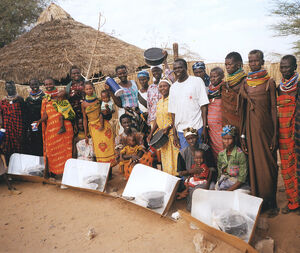
Refugees from Sudan are trained by Solar Cookers International in the use of their new CooKit solar cookers.
- The Kakuma Refugee Camp was the first to receive a large scale solar cooking project - The Kakuma Refugee Camp was formed in 1972 when Sudanese refugees first arrived in Kakuma, Kenya. Introducing solar cooking to the camp was Solar Cookers International’s first and largest refugee project, beginning in January 1995. Kakuma had considerable refugee turnover, but by 2004, when Solar Cookers International (SCI) concluded the project, the camp had tripled in size to nearly 90,000 refugees. Though rapid growth posed problems for assisting all those who wanted to solar cook, SCI ultimately served over 15,000 families. This project was one of the earliest to use the CooKit solar panel cooker to introduce solar cooking. The program also extended solar cooker technology to schools, especially primary schools, through demonstrations, poems, songs and drama.
News[]
- NEW: March 2024: Nicholas Kithembe of the Tonembee Association reports a successful solar cooking demonstration by Kithuia Integrated Solar Cookers at the primary school games, attended by over 1,000 people at Kithuia Village in Kenya.
- NEW: March 2024: Producing more Funnel solar cookers: - Didacus Pius Odhiambo has provided photos of assembling several more Funnel solar cookers for Farmers with a Vision.
- October 2023: A celebration at the completion of a successful integrated solar cooking workshop in Kenya’s Kwale district, led by the engineer Penina Nzioka, with coordination assistance from Bernhard Müller.

Bernhard Müller attends the workshop celebration at the completion of participant training, led by engineer Penina Nzioka. The handsome heat-retention baskets on display were assembled by the group, Photo credit: Penina Nzioka
- September 2023: Camily Wedende of Sun Cookers International provided a solar cooking demonstration to Kenyan locals in West Pokot County. Attendance was greater than expected, so food portions had to be rationed some. Camily used a collection of Haines 1 solar panel cookers provided by Roger Haines to prepare a midday meal. Participants witnessed solar cooking in action for the first time, and were quite impressed.
- Participants pose with the Haines 1 solar cookersPhoto credit: Camily Wedende
- April 2023: Nicholas Kithembe of the Tonembee Association has provided photos of a recent Integrated Cooking Method demonstration at Kithuia Village sponsored by Sub Country Sports. They displayed the use of the CooKit, Haines 1 , Haines 2.0 solar cookers, the water purification WAPI indicator, and how to use a fireless basket for heat-retention cooking.
- Photo credit: Tonembee Association
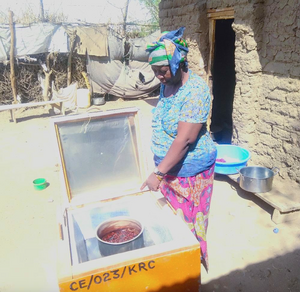
Woman examines an Ecomandate Foundation built solar box oven at the Kakuma Refugee Camp, Photo credit SCI
- March 2023: Solar Cookers International in partnership with the Ecomandate Foundation - The organizations have implemented an ongoing solar cooking project at the Kakuma Refugee Camp in Kenya. Solar Cookers International emphasizes and applies best practices in project development and project monitoring and evaluation. Ecomandate Foundation brings hands-on construction, their local experience as part of the community, and familiarity with local customs, practices, and languages. Read more...
- February 2023: A multi-day solar cooker construction and use workshop took place in Eldoret Kenya. It became a reality through the efforts of a number of supporting individuals, non-profit organizations, and manufacturers. The solar panel cooker materials were provided by Haines Solar Cookers, with general funding by the Rotary Club of San Diego. Solar Education Project founders, Mary Buchenic and Jennifer Gasser wrote workbooks and translated them into Swahili for the participants. Additional project support was provided by Solar Household Energy. The workshop leader was Grace Chepkemei, who was assisted by local solar cooking advocate Camily Wedende. Participants were excited about the training, and surprised at the variety and excellent taste of the foods they prepared.
- December 2022: Visit to Farmers with a Vision by Joshua Katagwa of Mayunge, Uganda and Maimuna Nangobi of Jinja Renewable Consult, Uganda. They were shown how the solar box cooker and the evacuated tube solar cooker are operated, and assembled.
- Using the solar box oven is explainedThe operation of the evacuated tube solar cooker is demonstrated
- Photo credits: Farmers with a Vision
- December 2022: In April 2022 Bernhard Müller made a video how to make a fireless cookers at Armstrong Women Empowerment Centre in Kisumu, Kenya under the leadership of Elva Rebecca "Beckie" Ondiek. "It took two full days of intense work to make. The video was first published with German subtitles on YouTube. It took me a very long time to look for somebody to help me editing the video in English language. Eventually, Sara Hjalmarsson of Engineers Without Borders - Sweden (EWB-S) did this absolutely stunning work." The video is now available by clicking on the link: DIY Heat Retention Baskets - Fireless Cookers
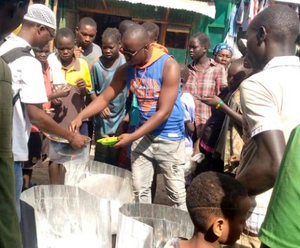
Kihuha Bruno demonstrates a Haines panel cooker by preparing a meal at the Kakuma Refugee Camp, Photo credit: Kihuha Bruno
- December 2022: Kihuha Bruno has been a longtime advocate of using solar cooking, particularly with those having limited resources. He has worked frequently at the Kakuma Refugee Camp in Kenya demonstrating the effectiveness of Haines Solar Cookers, thereby avoiding deforestation from firewwood collection, and respiratory illness from using open fires for cooking.

Fireless cooker workshop with Samuel Odhiambo in Nairobi, Photo credit: [[AfriShiners]]
- August 2022: fireless cookers: Samuel Odhiambo from AfriShiners ran a fireless cooker workshop in Nairobi recently.
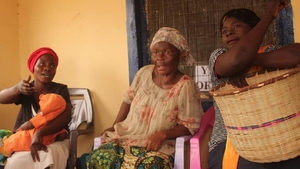
The Solar Education Project reports that Grace Chepkemei shared her skill and knowledge about solar cooking and heat-retention basket cooking, Photo credit: Solar Education Project
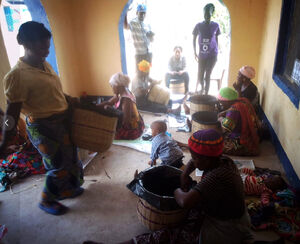
Heat-retention cooking baskets were constructed at the workshop.Photo credit: Solar Education Project
- May 2022: Solar and heat retention cooking workshop - The Solar Education Project reports that Grace Chepkemei shared her skill and knowledge about solar cooking and heat-retention basket cooking at a workshop at the Kakuma Refugee Camp. These skills demonstrate how the Integrated Cooking Method will benefit the trainees and community.
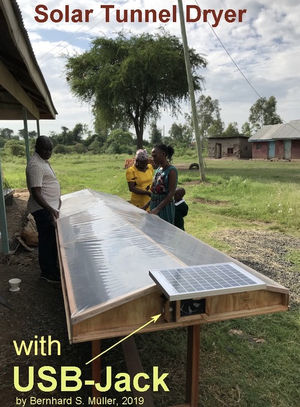
Solar tunnel dryer designed by Bernhard Müller for his partners in Kenya and Uganda Photo credit: Bernhard Müller
- January 2022: Solar tunnel dryer design for Kenya and Uganda: - Bernhard Müller offered his design skills in helping to create a new solar tunnel dryer for his partners in Kenya and Uganda. A 10W solar panel powers a fan providing air flow and enables the people who work with the dryer to charge their phones simultaneously.
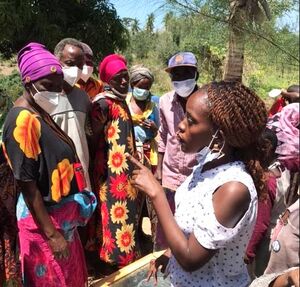
Solar cooking demonstration in Mwandogo by Penina Nzioka
- September 2021: Solar cooking demonstration in Mwandogo - Penina Nzioka conducted a workshop to demonstrate the potential of solar box cookers in her hometown, located nearby to Mombasa.
- June 2021: Taxes help and hinder solar cooker sales in Kenya - Previously, there has been a value-added tax on the purchase of raw materials used for manufacturing solar cookers within the country. Amounting to roughly 16% in additional cost, manufacturers said the savings will be passed on to the consumer. However the government has also removed the tax exemption for clean cooking appliances, as well as other less polluting technologies. This will discourage wider adoption and slow the improvement of air quality. Still widely used, charcoal, retains its tax-exempt status. Read more...
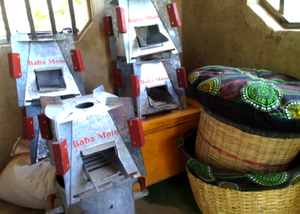
Millicent Anyango's display of stoves and fireless cookers in Migori County, Kenya
- May 2021: Bernhard Müller reports in the AfriShiners Newsletter that Millicent Anyango maintains a supply of Baba Moto improved combustion stoves and fireless cookers from her location in Migori County, Kenya. She also organizes clean-cooking and fireless cooking workshops throughout western Kenya. Penina Nzioka, another AfriShiner member from Mwandogo nearby to Mombasa, trains the women in her village in the use of fireless cookers, and how to process coconut oil in a solar box cooker.
- March 2021: The Solar Cookers International Order of Excellence annual award for 2020 has been given to the Republic of Kenya for including solar cooking in its Voluntary National Review (VNR) to track progress towards achieving the Sustainable Development Goals (SDGs). The award recognizes the most outstanding people and organizations whose sustained efforts have contributed most to empowering people to cook food and pasteurize water with solar energy.

John Amayo conducted a workshop on the Integrated Cooking Method in Kisumu, Kenya. Photo credit: John Amayo
- January 2021: John Amayo conducted a workshop on the Integrated Cooking Method in Kisumu, Kenya. Participants learned about using solar cookers, heat retention cooking baskets, and improved-combustion stoves to best effect in both sunny and cloudy conditions.
- December 2020: Solar Household Energy has adopted the 100 Families Project that provides groceries, cooking devices, and other support for 100 families locked down in the Kariobangi slum in Nairobi Kenya.
- December 2020: Samuel Odiambo of the Asulma Centre, in conjunction with Didacus Pius Odhiambo of Farmers with a Vision, trained Grace Mubi and Sarah Ndunyo, of Shambani Millers Self Help Group, and a group of villagers from Kitui, Kenya, about the techniques of Integrated Solar Cooking.
- Villagers learn about solar panel cookersHeat retention cooking is explained to workshop participants
- Gallery photo credit: Farmers with a Vision
- November 2020: SCI shares successes at the ReEnergy Africa E-Summit - SCI's Executive Director Caitlyn Hughes discusses the impact of solar cooking around the world and shared success stories from Kakuma Refugee Camp, Kenya. Watch video
- November 2020: A new local partner agreement has been signed between Engineers Without Borders - Sweden and the Asulma Centre Self Help Group to diffuse solar cooking to more areas of Kenya.
- October 2020: Ksh.500M released for 14 counties in off-grid solar project - Citizen Digital
- October 2020: Counties get Sh500m for solar, clean cooking kits - Business Daily
- May 2020: Kenya inventor wins American Society of Mechanical Engineers (ASME) award for solar cooker boiler - "Ecobora invented a “solar cooking boiler”, which stores solar energy in a repurposed oil tank with waste motor oil as carbon sink tank, eliminating need for firewood and allowing use to cook round the clock. Rural marginalized schools in Kenya are using money saved from not buying wood to equip science and computer labs." More information
- March 2020: Global Off-Grid Solar Forum & Expo - The three-day forum and exposition opened in Nairobi on February 18th with many contributing experts from various parts of the world. The President of Kenya, Uhuru Kenyatta, was also present on the first day of the Expo to assure his government's enthusiastic support for the development of off-grid solar products for use in Kenya. The science of solar cooking and e-cooking were also featured topics of discussion at the forum. More information...
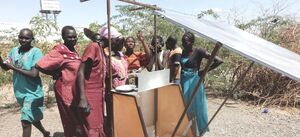
Kakuma residents with on of the Heliac solar cookers provided by Solar Cookers International
- February 2020: In 2019, Solar Cookers International provided 300 people, women and their families, with solar cookers and the training to use them in the Kakuma Refugee Camp. More information...
- November 2019: Community bakery - GoSol.org reports that one of their solar array cookers, first put into use in 2017 in the Kisumu area, in Kenya is still in use. It was later transferred to Friends of Ndere, a very active baking community, which already had a GoSol concentrator. In spite of this being one an early pilot unit, they are still using this unit to bake bread. Below is a video in Swahili showing the concentrator in action. More information...

Farmers with a Vision cooking in front of store
- April 2019: Kenya learns to cook with solar power - even when the sun doesn't shine - (Reuters) In Busia County, in western Kenya, as many as 1,500 households have turned to solar cooking, mostly over the last four years, according to county Ministry of Energy figures. Other families have adopted more efficient charcoal or firewood stoves. The changes in large part have been driven by Farmers with a Vision (FWA), a local community organization based in Bumala Township.
- June 2019: Dr. Alan Bigelow's Journal on Kakuma Refugee Camp, Kenya - Solar Cookers International
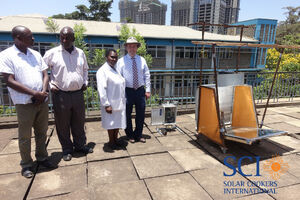
The Performance Evaluation Process in action
- June 2019: Solar Cookers International opens new PEP testing center at the University of Nairobi, Kenya - SCI’s PEP test allows manufacturers and consumers to know the cooking power of solar cookers without brand bias and to develop a baseline for comparison. PEP testing demonstrates to solar cooker users and investors the power, in watts, they can expect from a specific model of solar cooker. SCI PEP results are trustworthy because the PEP test is based on an internationally accepted protocol for testing and reporting solar cooker performance. SCI also has centers in Lalitpur, Nepal; New York, USA; and California, USA. Having global locations for SCI PEP testing centers is important to advancing the adoption of solar cooking worldwide and affirms SCI’s role as the leader within the solar cooking sector. Local testing of solar cookers supports the regional economy, job growth and builds capacity in the sector. [1]
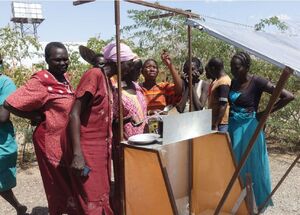
Refugee women with a Heliac Solar Cooker
- June 2019: Solar Cookers International has recently brought life-saving solar cooking to more than 300 people in the Kakuma Refugee Camp. Before you stepped in, women were often forced to sell their precious food rations for cooking fuel, putting their children at risk of malnutrition. If they dared to journey outside of the camp to collect firewood, they risked violence.
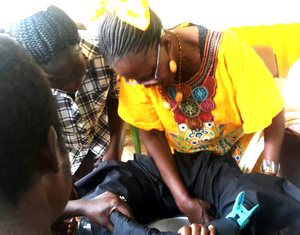
Fireless cooker workshop held at the Armstrong Women Empowerment Centre in Rabuor under the direction of Faustine Odaba. Photo credit: John Amayo
- March 2018: The fireless cooker workshops held at the Armstrong Women Empowerment Centre in Rabuor are made possible with donations from Lernen - Helfen - Leben e.V. in Germany. The workshop is led by Faustine Odaba of Natural Resources and Waste Management Alliance (NAREWAMA) based in Nairobi.
- February 2018: New Scheffler cooker installed by Altener Solar: Facebook video
- January 2018: The Tonembee Association reports that it distributed 150 solar cookers in Kithuia Village in April, 2017 and held three educational events in the area between February and June, 2017.
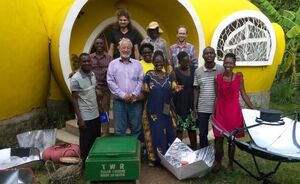
Photo credit: Bernhard Müller
Climate and culture[]
- The climate of Kenya - Wikipedia
- Kenya Energy Situation - Energypedia
- Discussion of eastern Africa's suitability for solar cooking
- Solar cooker dissemination and cultural variables
Resources[]
Possible funding[]
Facebook groups[]
- Integrated Solar Cooking - Kenya
- Asulma Centre Self Help Group
- Farmers with a Vision
- Solar Cooking Introduction
- Student Solar Cooking Science Projects Eldoret, Kenya
- Tonembee Association
- NEW: Ecomandate
Project evaluations[]
- October 2008: Sunny Solutions Project in Nyakach Constituency, Nyanza Province, Kenya - Evaluation Report to Solar Cookers International - An independent evaluation of the Sunny Solutions Project in Nyakach Constituency, Nyanza Province, Kenya. The report examines the impact of solar cooking on the area, associated variables, the results of the project, and recommendations for how to improve future projects.
- September 2008: Sunny Solutions Program, Nyakach, Kenya - Evaluation Report to Solar Cookers International - An independent economic analysis of the Sunny Solutions Project focusing on how the business model for similar projects could be improved in the future.
- March 2007: Solar Cooker Dissemination in Kenya - Evaluation Report to Solar Cookers International - A summary of economical, environmental, and health-related issues in rurual Kenya that have the potential to be remedied with the use of solar cookers. Report includes conlcusions of the project and lessons learned.
- April 2006: Summary of Lasting Impacts of Solar Cooker Projects - Solar Household Energy, Inc. - A general summary of long-term effects of solar cooker use in refugee camps in Ethiopia, Kenya, and Bolivia.
- December 2003: Evaluation of the Solar Cookers International Solar CooKit Project at the Kakuma Refugee Camp, Kenya - The final evaluation of the Solar Cookers International project at the Kakuma Refugee Camp in Kenya. Report discusses the decreased dependence on wood as fuel, environmental effects, and socio-cultural impacts.
- August 1998: Summary of wood consumption study in Kakuma by Drs. B. Knudson and B. Lankford August 1998. - A paper discussing the methods and findings of a pilot study conducted in the Kakuma Refugee Camp to determine the effects of solar cooker use on fuelwood savings.
Reports[]
- March 2023: Eldoret National Show Report, 1-4 March 2023, - Grace Chepkemei
- March 2023: Chalmers Masters Thesis on Kenya Solar Cooking - Alaa Abdul Sater & Johanna Tolly
- April 2020: Kenia Brief (German) - Mount Kenya Energy Project
- July 2019: The Kenya eCookbook: Beans & Cereals Edition - How to Save Time and Money
- May 2017: Solar Cooking—the solution to environmental impact and fuel scarcity in Kakuma Refugee Camp - Godfrey Mawira Kaburu
- January 2017: The Loodariak Kenya Village Solar Cooker Project - Collaborative Knowledge Transfer - Jean Golden and Peter Haastrup
- October 2013: The Goal is Zero: A Strategy to Eliminate Water-Borne Disease in Lower Nyakach, Kenya (Report and Slides)
- June 2010: Solar Cooking Demonstration at the Mara in Narok; Kenya
- July 2008: East Africa Report - Karyn Ellis
- May 2008: SCI’s Kenya Program: Sunny Solutions and Beyond - Karyn Ellis
- September 2006: The Special Challenges of Solar Cooking
- Fall 2006: Mpala, Kenya: A Summer of Teaching, Research, and Learning - Ishani Sud
- June 2006: Lasting Impacts of Solar Cooking in Kenya - Melanie Szulczewski, Ph. D.
- A page with chronological reports from the Solar Cookers International solar cooking project in the Kakuma Refugee Camp in Kenya.
- May 2003: A Market-Based Strategy for Introducing Passive Solar Ovens in Kenya
Articles in the media[]
- September 2023: 2023 Summit: Kano ACReSAL Project Coordinator atins Other Experts at Africa Climate Summit In Nairobi in building solar cooking resilience - Solace Base
- February 2023: Mirror solar cooker invention to reduce deforestation - STAR
- February 2023: Kenyan solar-stove may cut cancer risks caused by burning wood -Africa News
- March 2021:Kenya recognised globally for promotion of clean cooking - The Star
- November 2020: Innovative Solar Cooker, Transforming Households - Kenya Climate Innovation Center
- October 2020: Ksh.500M released for 14 counties in off-grid solar project - Citizen Digital
- October 2020: Counties get Sh500m for solar, clean cooking kits - Business Daily
- June 2020: Experts oppose tax proposal on solar and cookstoves product - Standard
- November 2019: Kenyan Ministry of Energy launches first national Gender Policy in the energy sector ever - Energia
- November 2019: Long way to Kenya’s dream of clean energy - The East African
- March 2018: To restore depleted forest cover, Kenya must take concrete steps - Daily Nation
- April 2017: Kenya learns to cook with solar power – even when the sun doesn’t shine - Reuters
- October 2016: EcoZoom meets Mama Solar! - Ecozoom UK
- May 2016: Kenya’s Young Inventors Shake Up Old Technology - Inter Press Service
- February 2016: Solar ovens help fuel future - The Whig
- December 2015: India's Solar Initiative and the Challenge of Climate-Safe Development (included in interview is President Kenyatta) - Living on Earth
- October 2009: Kenya: Entrepreneurs Cashing in on Green Campaign - Business Daily (Nairobi)
- April 2009: Inventor turns cardboard boxes into eco-friendly oven - CNN (Solar Cookers International alerted CNN that this invention is not new. CNN then updated the story to mention the work of SCI and others.)
- March 2009: The five fighters of climate change - Financial Times
- April 2008: Kenyans Tap Sun to Make Dirty Water Sparkle - Women's eNews
- November 2007: Kenya safe water project to include innovative testing, pasteurizing tools - Solar Cooker Review
- November 2007: Kenya: Solar power on the rise - East African Standard
- May 2007: Sacramento’s Solar Cookers International uses the sun to improve quality of life, one village at a time - Sacramento News Review
- February 2007: Rural Kenyan women on vanguard of African solar revolution - Agence France Presse
- December 2006: Student sows seeds of community-helping technology in Africa - News@Princeton
- November 2006: Kenyan women look to the sun for cooking - Mail and Guardian
- March 2006: Truckee Rotary clubs heat things up in Kenya - Sierra Sun
Audio and video[]
- February 2020:
- May 2017:
- January 2017:
- January 2017:
- 2014:
- December 2014:
- March 2013:
- August 2012: Solarkocher für Kenia - WDR (English version)
- August 2010:
- February 2008:
Tusk Trust Documentary - 13 Solar Energy
Tusk Trust documentary of introducing the CooKit in Kenya in 2008.
Documents in local languages[]
Luo[]
Climate and culture[]
Solar Cookers International has rated Kenya as the #13 country in the world in terms of solar cooking potential (See: The 25 countries with the most solar cooking potential). The estimated number of people in Kenya with fuel scarcity but ample sun in 2020 is 5,900,000. Solar cooking must be introduced in an area with sunshine for at least 6-9 months a year for the technology to be deemed useful. Highlands are often cloudy and overcast and so people tend to go back to their old ways.
Fuelwood provides 79% of Kenya’s total energy use. Each day Kenyans burn 37 million kilos of wood and 6 million kilos of charcoal.
Statistics indicate that nearly 25 per cent daily income of urban folks is spent on fuel. This money could be channeled into more pressing needs like education, medicine, housing or other investments if this new technology were to be embraced.
Mattias Goldmann of the NGO Tricorona reports that he was told that several Kenyan tribes have a "strong taboo" against cooking outside.[2]
Dinah Chienjo of Friends of the Old reports, "The people have since time immemorial believed that water was blessed from the beginning and cannot cause any diseases but through the education and by showing them the results of the tested waters and telling them the dangers of the germs on the body, they are beginning to change their drinking habits and looking back many people agree that the many stomach related diseases they have suffered in the past have been a result of the bad river or pond water they have been drinking." See Water pasteurization.
The Kenyan government has banned the use of plastic bags. This makes the use of these as a glazing in a solar cooker impossible. See alternatives to plastic bags in the Glazing article.
See also[]
- Example of Site Suitability Study for Kenya - Solar Household Energy
- November 2019: Long way to Kenya’s dream of clean energy - The East African
- Cookbook: The Kenya eCookbook: Beans & Cereals Edition - How to Save Time and Money
- The Special Challenges of Solar Cooking - Charles Onyango-Oloo
- The climate of Kenya - Wikipedia
- Kenya Energy Situation - Energypedia
- View an interactive map of Kenya
- Now that the Kenyan Government has banned plastic bags, it might necessary to use other simple glazings to surround the cooking pot
- Discussion of eastern Africa's suitability for solar cooking
- Solar cooker dissemination and cultural variables
History[]
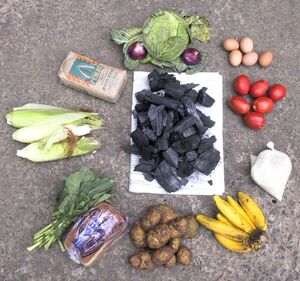
Each group of items costs the same as does the pile of charcoal shown. By using a CooKit or other solar cooker, people can buy food instead of fuel.
Kenya has been the center of solar cooking activity in East Africa. A number of organizations have endeavored to promote the technology in this country, which has been the commercial hub of the area for several decades. Its capital, Nairobi, is also well served by air, making access to the nation and region readily available, using Nairobi as entry point.
The promotion of solar energy is decades old in Kenya. As far back as 1977, GTZ (the Germany's official technical aid agency) initiated and later abandoned a project in Nairobi. The reason given had to do with the fact that the products used were made in Germany, and were not available in East Africa. Two different Catholic missions in rural Kenya tried solar cooking introduction, but no information is available on the outcomes. As early as 1991, a few solar ovens were exported to Tanzania (through Trans World Radio, perhaps), indicating that the product presented a business opportunity. In 1992, an Earthwatch grant permitted an academic, Dr. Daniel Kammen, to begin a multi-year study of renewable energy technologies, including solar cookers, using volunteers in short-term Earthwatch projects.
Other early efforts included the work of Trans World Radio to promote solar use, within the Girl Guides organization. It was a large project begun under the auspices of the Institute for Cultural Affairs, and also with the effort of a remarkable Peace Corp Volunteer. In the mid-1990s, with assistance of Solar Cookers International (SCI), a national coordinating body for the purpose of sharing information and strengthening progress by collective action around the topic of solar cooking was formed in Nairobi.
Among those early efforts was the activity of Trans World Radio (TWR). TWR work began in the early 1990s. A conference proceedings on Renewable Energy Policies in East Africa, held in 1993, included a paper by TWR coordinator [[Clive Wafukho]] on their work in solar cooking. This organization promoted solar cooking on its radio programs, made and sold box cookers in the Nairobi environs, and worked also in a distant refugee camp. They pioneered solar cooking in Kakuma Refugee Camp, where SCI later established another project. TRW estimated that in the period between 1992 and 2001, they distributed a total of 2,350 cookers in the camp and other localities in Kenya. Logistics and staff support were always problems in the remote areas. In 2000, there was an attempt to solve that problem with the training of refugees as carpenters to be able to build the cookers within the camp itself. TRW reported the production of 400 cookers.
The cookers were large and well suited to the needs of the Sudanese population living in extended family compounds, and required cooking for 10-20 people daily. Trans-World Radio demonstrated remarkable staying power in this difficult to serve area, which had a population that could not afford to buy the expensive box cookers. Therefore, most were given away free, with funds raised for the most part outside of Africa. TWR estimated that two-thirds of the cookers are used regularly.
In roughly the same time period, U.S.Peace Corps volunteer, Barbara Ross, was assigned to an area in western Kenya. Her responsibilities were varied, but, but aside frome of her assigned tasks, she began to promote of solar cooking. Ms. Ross recruited and trained a number of women where she worked, who then formed themselves into a Housewives' Club, and proceeded in turn to teach others. They made solar box cooker of cardboard, which worked very well in a propitious climate, and solar cooking was on its way in this part of Kenya.
The interest of Girl Guides with solar cooking also goes back to roughly the same time period. An early training program was initiated in Kenya by Barby Pulliam, chief promoter of the World Association of Girl Guides and Girl Scouts. Little remains of that single demonstration, but it did serve as a foundation for later work that was developed more fully in the late 1990s. An interesting offshoot of that program was a unique program begun by a Girl Guide troop in Kakuma refugee camp. It was run by individuals originally inspired by the work of Ms. Pulliam.
The Institute for Cultural Affairs, (ICA), which had a long term presence in the development community, focused on empowering local communities to define their own needs and plan their own development strategies. Solar cooking was somewhat of a side interest for ICA, though obviously related to its larger mission. To carry out the solar cooking mission, a Swiss volunteer, long interested and skilled in the technology and in training others, joined the Nairobi staff of ICA, for the specific purpose of promoting solar cooking. ICA created a solar box cooker construction course at a local technical school, which ultimately produced all the cookers used by ICA in the communities where they worked. ICA used a classical community development approach in their work. In community meetings, workers persuaded community members to define their needs and existing barriers, which prevent adoption of solar cooking. Fuel shortage was a major problem, and hence solar cooking promotion became an ongoing part of the program in many areas of Kenya. Unfortunately, the solar activity more or less ceased after the very effective volunteer returned to her home.
The agencies described above formed the core of the solar cooking consortium formed in 1994, with some financial aid from SCI. The purpose of the consortium formed around solar cooking was to share information with one another, and to enlist additional person power for promotional activities. SCI provided financial and moral support to the effort for some years. One conference was held in Nairobi, and one in outstate Kenya, with the hope of involving additional people in the effort. Ultimately, the logic of solar power technology dictated that purveyors and promoters of photovoltaic technologies would also be included in the group. Over time, and after finally achieving NGO status in Kenya (not an easy task), the organization came to be dominated by the larger and considerably-more powerful community of business and industrial photovoltaic personnel in Kenya and thus of less value to solar cooking promoters.
Shortly after the creation of the consortia arrangement in 1994, SCI accepted an invitation from the United Nations High Commissioner for Refugees to embark on a demonstration project in a refugee camp. The story of the project in the Kakuma refugee camp has been recounted elsewhere, therefore recounting here will be brief. The program was carefully planned (insofar as that was possible for an organization, which had not previously worked in an overseas setting) and carefully monitored throughout the project. Kakuma is located in the semi-arid Rift Valley in the far northeast corner of the nation, reachable only by air (or 20 hours on a rickety bus). The camp grew from what seemed a very large 28,000 initially to almost 100,000 at one point, with major changes in the ethnic makeup. Logistical problems were always difficult, as the camp, being so remote, was not easily accessible. Eventually, a Kenyan staff was formed, and the camp work in 2004 (8 long years later), phasing into a refugee-run cooperative with similar purposes to the original SCI project, i.e., a demonstration that people in need can and will adopt solar cooking, save fuel and scarce financial resources, while inflicting less harm on the already fragile environment.
After a successful start at Kakuma camp, Solar Cookers International was invited to initiate a similar project at remote Aisha refugee camp in Ethiopia.
The November 2003 issue of Solar Cooker Review carries to recount of Sunshine does let them eat cake about a woman refugee, Mumina Baraka, who has operated a small-scale bakery in Kakuma, selling in small quantities to make a living, and to provide baked goods for other refugees to purchase. She planned to take her CooKit back to Ethiopia with her when that became feasible.
Somewhat later, a Rotary project in Nairobi was started, but turned out to be less than wholly successful, perhaps showing the difficulty of working in urban areas. The need is considerable, but space, security of food and cooker, etc. are difficult issues in congested poorer urban areas.
During the early years of the Kakuma camp program, the solar cooking program generated considerable interest in refugee circles. All visitors were taken to the training sites and, when advance notice made it possible, given a meal cooked by the sun. SCI's refugee coordinator, a Zairean woman who spoke excellent English, became almost a camp staff person, and was frequently called on to accompany visitors, to translate for them, and to provide demonstrations. One of the visitors in the early years was a UNHCR staff person from the head offices of the UN agency in Geneva. He was integral to beginning the program in Ethiopia. In addition, he discussed the possibility with SCI of working in Dadaab refugee camp in Kenya, located on the Somali border, to the east and north of Nairobi. That camp, almost entirely Somali in population, was far bigger than Kakuma (with about 100,000 residents) and differently structured, with three separate sub-camps, each located at a distance from the central offices of the organizations which served the camp.
The camp administrator in Dadaab was enthusiastic about starting a solar cooking program. Activities directed at energy conservation were well underway in the camp, under the direction of the German technical assistance agency, Deutsche Gemeinshaft fur Technische Zusammenarbeit (GTZ), which had been implementing an improved stove program for some years. That program used an interesting model of "work for a stove" in which individuals were given 25 tree seedlings to plant and cultivate at their own homestead. At the end of three months, if they had successfully nurtured the seedlings, the "gardener" was given a voucher to obtain a stove. The devices used were a somewhat larger version of a charcoal stove in use in Kenya for some years, one in which the fire bed was made of ceramic, then encased in a metal shell. The stoves were manufactured in a workshop run by GTZ, and were considerably more efficient than traditional three-stone fires. Trained "animatrices" were assigned to various parts of the camp, where they did extensive workshops showing people how to use the new equipment.
By the time GTZ heard about the solar program, the Dadaab staff had already provided stoves for over 90% of the camp's residents. Both GTZ and SCI agreed that adding solar cookers to the mix would be one more way to cut down on the use of wood fuel, which by that time had been declared unlawful by the Kenya government but was still routinely used. The team of GTZ extension workers, already trained in promotion of wood stoves, were given additional training in solar technologies, thus adding another tool to their fuel-saving repertoire. Eventually, SCI trained additional Dadaab women as trainers, in order to proceed at a faster rate in this huge camp.
An unfortunate event occurred next in Dadaab, one that effectively put an end to the solar cooking project and considerably dampened the improved stove project as well. A delegation of American congresspersons visited the camp. They were told stories of the dangers that women were exposed to in the collection of wood (unlike Kakuma, refugees were allowed to collect wood in the area, even though it was unlawful by order of the government). Dadaab is located only about 15 miles from the border with Somalia; the lawlessness of that country spilled over into the nearby camp. Cars were routinely hijacked, necessitating convoy travel to the campsites. Security was certainly a high concern. Some refugees had been robbed, a few killed, and some women raped and murdered while searching for wood. Naturally, this gained the sympathy of the congresspersons. On return to the US, they managed to add a rider to legislation already in process that provided several million dollars for the purchase of fuelwood for Dadaab.
Both GTZ and SCI were horrified at this well-meaning, but ultimately destructive act, which harmed the fuel-efficient stove program and effectively ended the solar cooking project. Obviously, free fuelwood was a far more attractive option. Two years later, the money for fuel was finished, and the programs promoting alternatives to fuelwood were no longer present in the camp. In the US, SCI attempted to protest, but was unsuccessful in obtaining a hearing on this emotional issue, taken up in good faith by ill-informed U.S. representatives. The solar cooking program in Dadaab program of SCI was closed and has not been restarted. {{SubSection}|Solar Health and Education Project (SHEP)}} A Swiss woman named Alison Curtis, working for an NGO called the Solar Health and Education Project(SHEP), provided a number of workshops in the coastal and other coastal regions of Kenya. The initial group of trainers was made up of teachers and public health workers, in order to encourage the introduction of simple solar technologies into school curricula and thus into everyday life. Both cooking and water pasteurization techniques were demonstrated and taught to participants. A second group of new solar cooks was simply introduced to the concept and practice of solar cooking in a basic training workshop, while a third group of experienced cooks reviewed progress in their respective villages (based on earlier training and promotion).
A second cluster of workshops was held in an area with a pastoral population that had not been previously exposed to solar cooking. The group made their own CooKits from recycled Tetra pack cartons (small boxes used to hold milk, lined with foil, which became the CooKit's shiny surface). After construction of the CooKits, the smaller groups cooked their meals, with the assistance of the trainers. As is common, amazement was the hallmark of the day! They loved the food and could hardly believe it had been cooked with the sun. In good pastoral style, one of the participants told Ms. Curtis "this initiative is like a cow given to us. We, the Masai, consider the cow the greatest gift one can offer. Let's utilize it". After the praise was given, a promotion committee was appointed to create an action plan to spread the technology in their area.
Working on behalf of the NGO in 2002, Solar Household Energy, Inc. (SHE, Inc.]] basically a team of graduate students from the University of Michigan, as a part of an assignment for a class in their MBA program, conducted an extensive market survey of solar cookers in Kenya. The students, supported by a generous donor to the school, conducted both phone and in-person interviews with knowledgeable sources in the U.S., Mexico, and within Kenya itself. The result was a comprehensive review of past and present solar cooking projects in Kenya, their market strategies, successful or failing, along with the views of a large number of opinion leaders from the government, the non-governmental community, and pertinent entrepreneurs and manufacturers. The students brought their knowledge from business school courses to bear on the problem, resulting in a useful document for promotion of solar cooking in the country. The document also served as a model for other related market research endeavors. Sponsored by SHE, Inc., this unusual effort turned out to be not only an excellent learning experience for students but also a quite useful document for different disciplines.
Perhaps of most interest, was a different program by SCI. The project, called Sunny Solutions, was established in an area near Lake Victoria. The project was located in Upper and Lower Nyakach divisions, not far from Kisumu, the third largest city in Kenya. Local organizations were recruited as partners and an intense awareness campaign involving a range of stakeholders from government, women's groups, churches, etc., was initiated. Initially, 150 women were invited to try the solar cooking at home; they were provided with CooKits, the cardboard cooker used in areas where families have limited resources and were given intensive training and an extended follow-up. In early 2003, a team of research consultants conducted an evaluation exercise to serve as a baseline for later program assessment of accomplishments in terms of fuel savings and health benefits.
In May 2003, fifteen women were recruited as trainers from the original pool of 150 solar cooks and sixteen women's groups. The trainers learned to solar cook all types of foods, carry out sales and home visits, keep sales records, and test and pasteurize water.
In July of 2003, the formal kickoff of the program began with a proper Kenya style community celebration, including solar cooked food, singing and dancing, visits from government officials and community leaders. Banners were strung over the site touting the wonders of the sun. The project was well organized with continuous careful monitoring to assure that the project remained on course as it moved towards its goals.
In 2005, hand-assembled CooKits were introduced in the community and given the nickname used to describe people of Nyakach - OYWA. Hand-assembly meant an increase in the profit margin received by the seller and a lower retail price for each cooking kit (a Cookit, plastic bags, WAPI, and instruction booklet). Those involved in the assembly process also received commissions for each well-assembled unit. By the end of 2006, the sales team had grown to 23 expert women, called Solar Cooker Representatives (SCOREPS); 4000 CooKits were sold; over 95% of the people of Nyakach were aware of the benefits of solar cooking; and Sunny Solutions had grown to include two more sites, Kadibo, a flood-prone area just outside Kisumu, and Kajiado, a drought prone area on the main highway from Nairobi to Tanzania.
Reports of other small-scale programs exist in Kenya; the ones desribed above are the longest lasting and largest known currently.
- Main article: History of solar cooking
Archived articles
- AVIF Volunteers in Kenya
- AfriAfya
- Altener Solar
- Charles Onyango-Oloo
- Co2balance
- Culinary Institute of Africa
- Imani Women's Group
- Japan Solar Cooking Association
- Lift Up Africa
- MWAYEO KENYA
- Magadi Cultural Group
- Michael Ongonga
- Naim Janmohamed
- Nancy Crooks
- Nancy Ellen Crooks Foundation
- Pastoralists Integrated Development Programme
- Peter Mwathi
- Project Harambee
- SCI’s Kenya Program: Sunny Solutions and Beyond
- Seat Partnership Foundation
- Solar Cookers International East Africa Office
- Solar Health and Education Project
- Solar Technology Kenya
- Sunny Solutions
- Wei Wei Women Group
Contacts[]
The entities listed below are either based in Kenya, or have established solar cooking projects there:
SCI Associates[]
- Main article: Solar Cookers International Association
NGOs[]
- Adventist Development and Relief Agency Somalia
- AfriShiners
- Asulma Centre Self Help Group
- Athel Technology Limited
- COMPE
- Co2balance
- Cucinare con il Sole
- Ecomandate
- Engineers Without Borders - Sweden
- Farmers with a Vision
- Friends of the Old
- Horn of Africa Regional Environment Centre and Network
- Imani Women's Group
- Japan Solar Energy Education Association
- Lady Fatemah Trust
- Lernen - Helfen - Leben e.V.
- Lytefire
- MWAYEO KENYA
- Mount Kenya Energy Project
- NAREWAMA
- Practical Action
- Rotary Club of Fresno
- Rotary Club of Gulu
- Solar Cookers International
- Solar Cooking KoZon
- Solar Fire
- Solar Household Energy
- Solar Liberty Foundation
- Solarinstitut Jülich
- Solvatten
- Student Solar Cooking Science Project
- Sun24
- Sun Cookers International
- Sustainable Utilization of Renewable Energy
- Tonembee Association
- Winam Jua CBO
- Wonderbag
Manufacturers and vendors[]
Individuals[]
Government agencies[]
Educational institutions[]
See also[]
- Category:Central Province
- Category:Coast Province
- Dadaab Refugee Camp
- Category:Eastern Province
- Hexagon Solar Cooker
- Ingelore Kahrens
- Kakuma Refugee Camp
- Kenya Solar Concentrator
- Kenya news archive
- Category:Nairobi Province
- Category:North Eastern Province
- Category:Nyanza Province
- Refugee camps
- Category:Rift Valley Province
- Safe Water Project
- Category:Western Province

